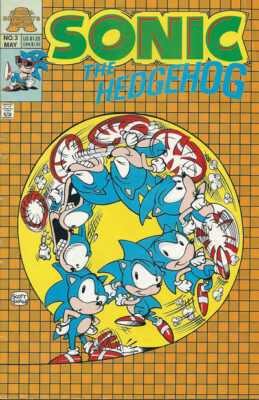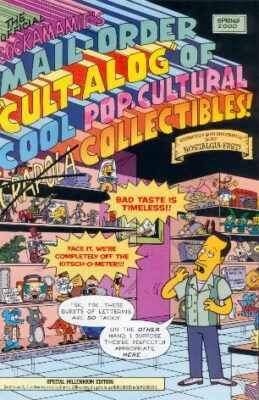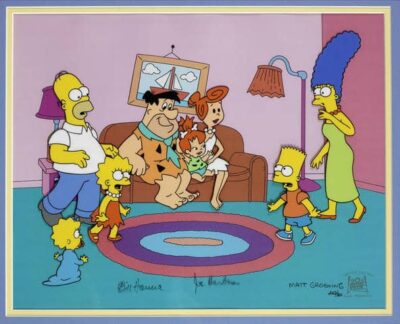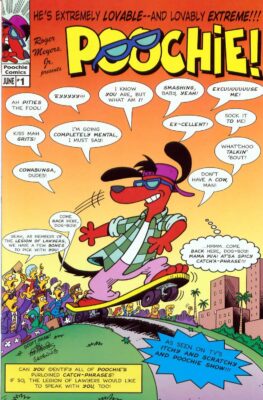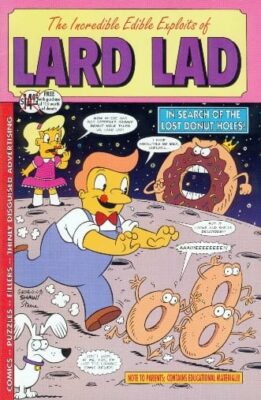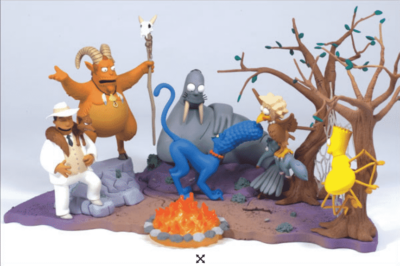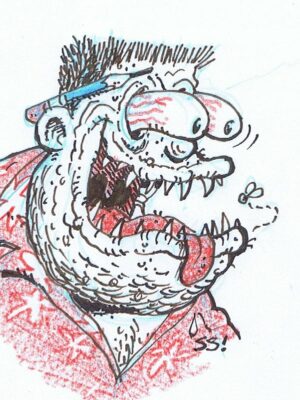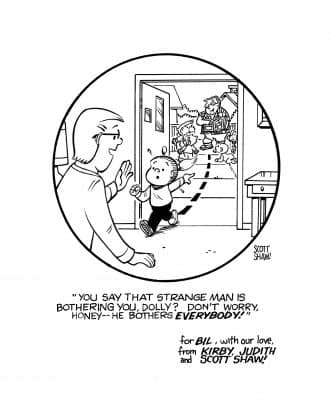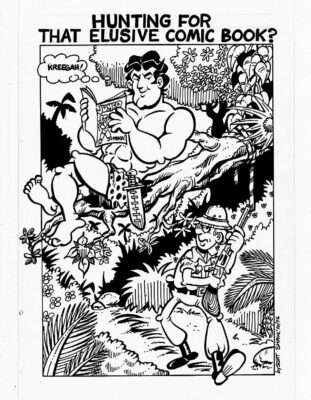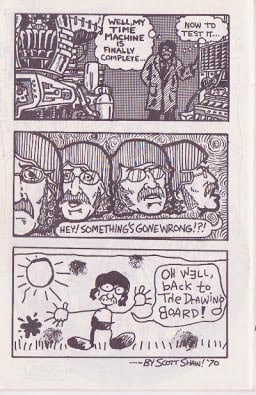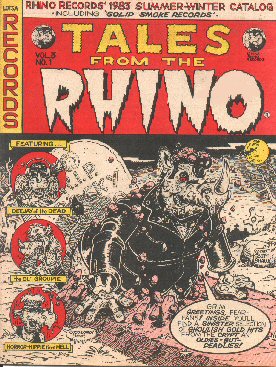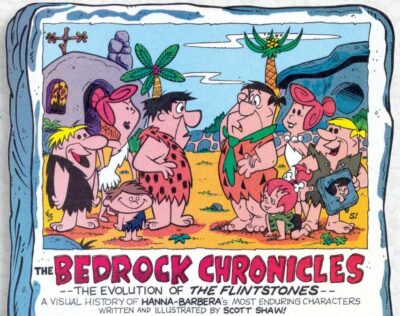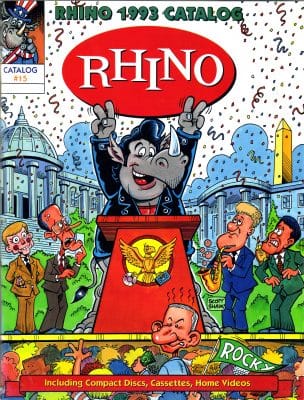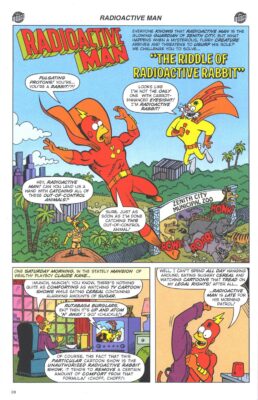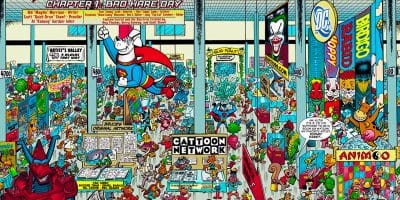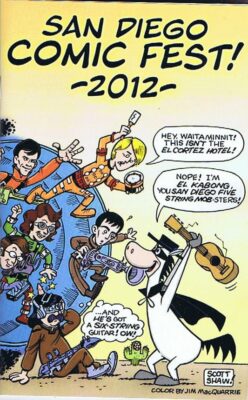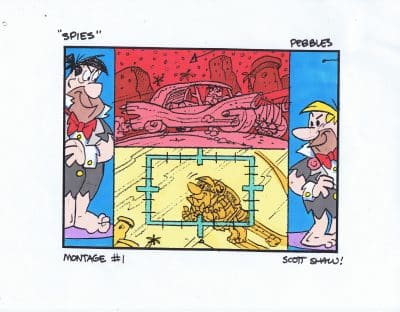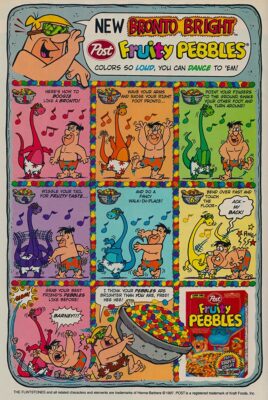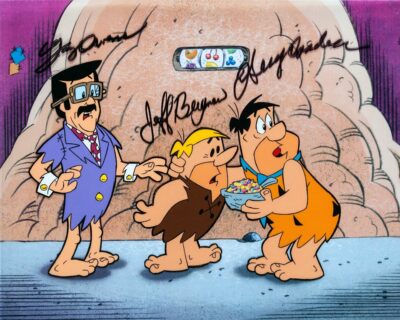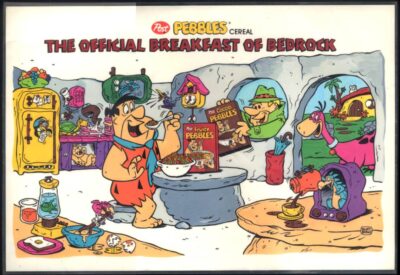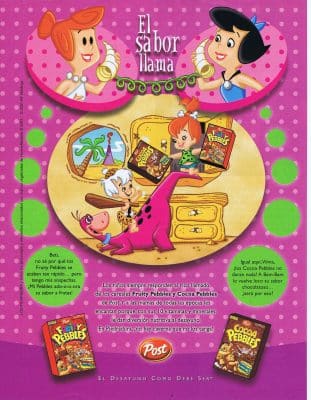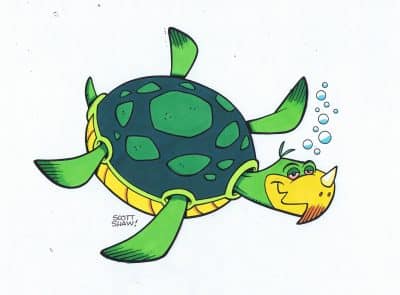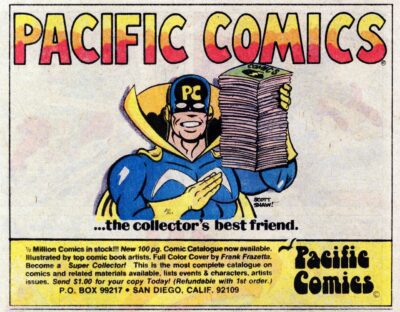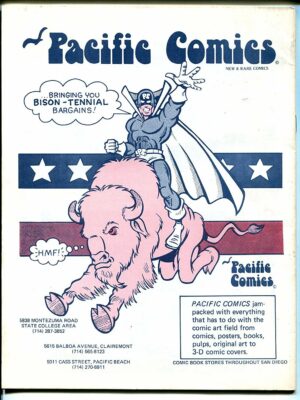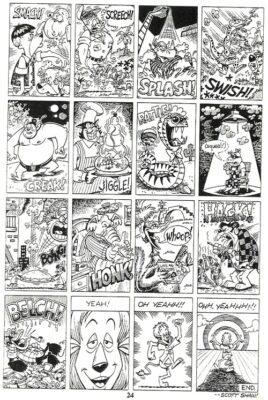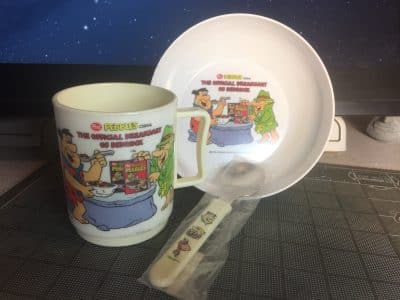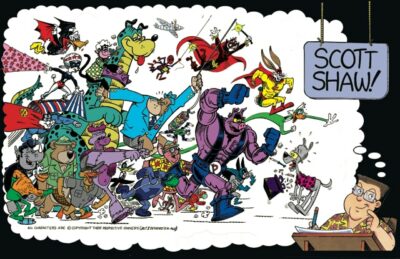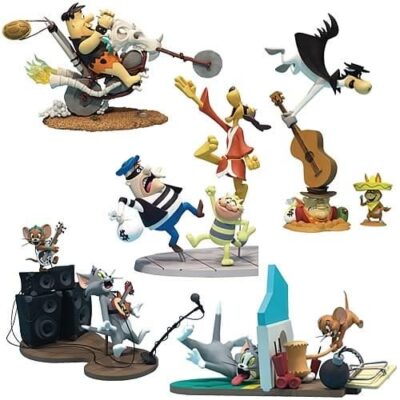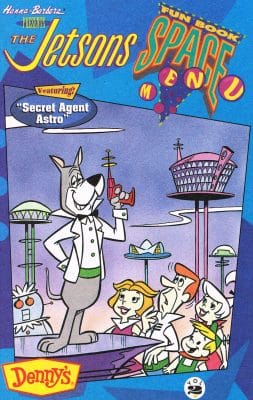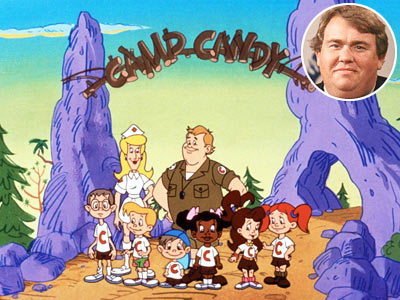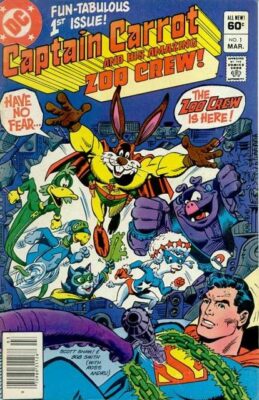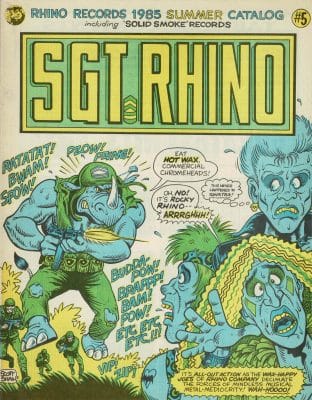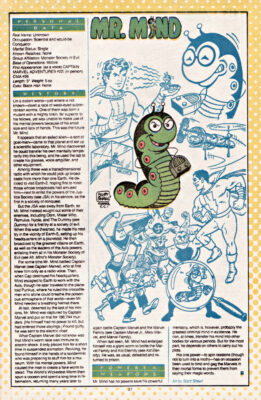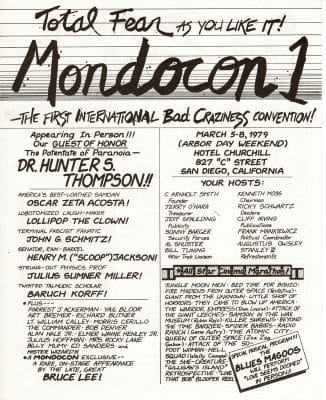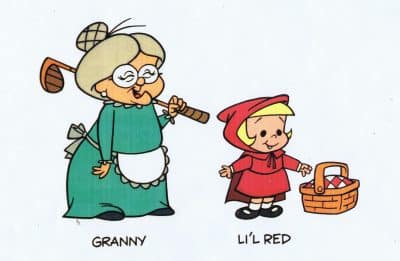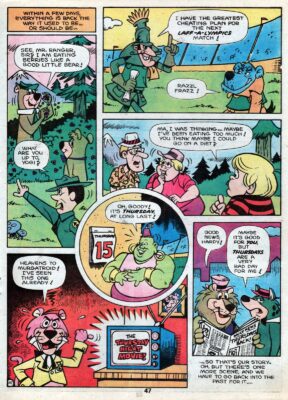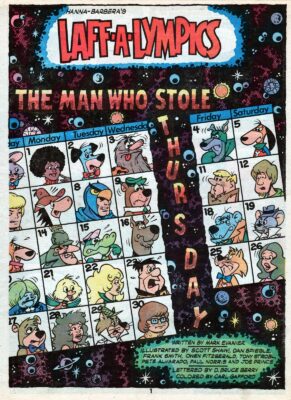Scott Shaw! Interview, King of Cartoons by Alex Grand & Jim Thompson
Read Alex Grand’s Understanding Superhero Comic Books published by McFarland Books in 2023 with Foreword by Jim Steranko with editorial reviews by comic book professionals, Jim Shooter, Tom Palmer, Tom DeFalco, Danny Fingeroth, Alex Segura, Carl Potts, Guy Dorian Sr. and more.
In the meantime enjoy the show:
Scott Joseph Shaw, often spelled Scott Shaw! and Scott Shaw? in Rick and Steve, is an American cartoonist, animator, and historian of comics. Among Shaw’s comic-book work are Hanna-Barbera’s The Flintstones, Captain Carrot and His Amazing Zoo Crew, and Simpsons Comics. Alex Grand and Jim Thompson interview animation wizard and cartoonist, Scott
Shaw! talking about his involvement in Underground Comics in the late 60s, early 70s, co-creating the San Diego Comic-Con, Hanna Barbera Comics, creating and producing Saturday Morning Cartoons like the Flintstones, Muppet Babies, Camp Candy, Ed Grimley, etc, making Saturday Morning Cereal Commercials, contributing to Disney Films, his 40-year career span as a Comic Historian researching Oddball Comics, and
his conversations with people like Rod Serling and Chester Gould.
🎬 Edited & Produced by Alex Grand, Thumbnail Artwork, CBH Podcast ©2021 Comic Book Historians.
Scott Shaw! Biographical Interview with Alex Grand & Jim Thompson
📜 Video chapters
00:00:00 Welcoming Scott Shaw!
00:01:25 Family background
00:04:32 Early reading & drawing
00:06:34 GATE Program; Gifted and (Talented) Education
00:07:30 Reading comics
00:09:46 Mort Weisinger
00:11:23 Artists, you admired
00:16:32 Bill Stout, Ray Harryhausen
00:17:39 Forrest Ackerman’s house
00:20:41 Scott at Comic-Con | San Diego mentors | Ronald Searle, Gene Hazelton
00:25:19 Interest in comics
00:29:52 Professional chronology
00:31:27 Children’s material
00:33:05 Hanna-Barbera, George of the Jungle
00:36:36 Dropped out of college in senior year | California State University, Fullerton
00:38:10 Hanna Barbera Comics
00:39:18 Gory Stories Quarterly, Ken Krueger | Garbage Pail Kids
00:42:20 San Diego Comic-Con
00:44:10 Jones of the Jungle, Savage Tales
00:45:11 Underground Comix, poster for Jack Kirby
00:47:57 Jack Kirby influence
00:51:32 Neal Adams
00:57:15 Marvel, Mark Evanier | Hanna-Barbera
01:02:48 Harvey Eisenberg | Yogi Bear
01:06:14 Career at Marvel at this point?
01:08:53 Association with Destroyer Duck
01:09:42 Joe Staton, Marty Pasco
01:12:08 Alex Toth
01:15:34 New Fred and Barney Show, 1979 design
01:25:52 Richie Rich cartoon
01:28:34 Muppet Babies | Smurf Script
01:35:03 B&W movies in Muppet Babies | Three Stooges
01:37:03 Muppet Babies
01:40:00 Popeye and Son, 1987
01:43:15 Garfield and Friends, 1988 | Mark Evanier
01:45:12 Ed Grimley, 1988 | Martin Short
01:51:32 Camp Candy, 1989-92
01:55:20 Fantastic Four Cartoon Series, 1994
01:57:30 A quick checklist
01:59:32 Captain Carrot | Roy Thomas | DC interference
02:03:30 Characters longevity
02:05:50 Captain Carrot, DC | Bill Morrison
02:08:58 Worst experience – Archie Comics
02:11:10 Experience with Bongo Comics
02:12:40 Working for Rhino Records
02:14:50 Interest in music
02:15:50 Streetwise Magazine
02:16:55 Sergio Aragones
02:19:09 Comic books proud of
02:21:20 San Diego Comic-Cons
02:24:10 What are you asked to draw the most?
02:24:40 Mark Russell’s Flintstones | Amanda Conner
02:29:30 Ad agency
02:34:07 Saturday Morning Cartoons
02:35:51 End of Saturday Morning Cartoons | Nickelodeon
02:37:44 The Flintstones
02:42:21 Oddball Comics, comic book historian
02:48:16 Ogden Whitney, Herbie | Nemesis
02:50:55 Steve Ditko, Tiny Toons
02:55:01 Exclamation point in the name?
02:57:07 Current work
03:00:06 Rod Serling, Al Capp
03:04:23 Li’l Abner
03:06:22 Chester Gould, Dick Tracy
03:09:42 R. Crumb and Jay Lynch
03:12:00 Conclusion
#ScottShaw #Flintstones #ComicBookHistorians #HannaBarbera
#SanDiegoComicCons #SDCC #SaturdayMorningCartoons #OddballComics
#SonicTheHedgehog #MuppetBabies #ComicHistorian #CBHInterviews
#CBHPodcast #CBH
Transcript (editing in progress):
Alex: Welcome again to the Comic Book Historians Podcast, with Alex Grand and Jim Thompson. Today we have a very special guest, Mr. Scott Shaw!. Scott has received four Emmy Award Certificates for story direction on Jim Henson’s Muppet Babies, an Eisner Award for his work on Bart Simpson’s Treehouse of Horrors #5 for Best Humor Publication, an Eisner Award for his work on Simpsons Comics 1999 for Best Publication for Young Readers, the San Diego Comic-Con’s Inkpot Award for Outstanding Achievements in Comic Books and Animation, the Humanitas Award for Camp Candy, the Shazam Award for Best Comic Book Humor Art, and a Squiddy Award for Superman & Batman: World’s Funnest. He was nominated for the Eisner Award for a set of Oddball Comics trading cards; Best Comics Related Product. The Reuben Award for Television Animation Division, and the Emmy Award for Outstanding Art Direction.
Scott is a member of the National Cartoonist Society, the Comic Art Professionals Society, and the Animators Guild. Welcome to the show, Scott.
Shaw!: Thank you very much. I’d forgotten I had done all that. Thank you.
[chuckles]
Alex: But it’s a good way to kind of frame what we’re about to dive in to. So, go ahead Jim, and start the early chapter.
Jim: Alright, so what we like to do, Scott, is to go through your earliest life. Where you were you born? When you moved, where ever you moved to? Which we know. A little bit about your interest in comics as a child, and also your family, and just get a sense of who you were when you were born…
I know you were born in 1951, and it was in Queens, New York, which is fairly typical for people we interview. But you didn’t stay there. You moved as a young person; you moved to the West Coast. Talk about your upbringing a little bit.
Shaw!: Okay. Well, both my parents grew up in Central Illinois, in a town called Decatur, Illinois which referred to itself as “The Soybean Capital of the World”. Then my dad joined the Navy while he was a kid, shipped out for boot camp in San Diego. That’s why we wound up in San Diego.
My dad always said that that was the nicest place he’d ever been. Even nicer than Hawaii, where he was shipped out to, and happened to be there during the time of the attack by the Japanese. His ship was capsized by an explosion. He survived. They made him an officer, almost immediately because they had lost a lot of people and they needed smart guys. My dad was a smart guy. He wasn’t an educated man, like I said, he grew up on a farm.
Shaw!: So, the reason I always say all that because that’s why we wound up in New York. My dad was the aid to an admiral. And even before I was born, my parents were living in the servants’ quarters in the mansion that this admiral had been placed in for a while on Long Island.
Anyway, I was born in the Navy Hospital. I guess my dad was re-stationed in San Diego. But knowing my dad, he’d figured out a way to get that all manipulated. He did this to the system all through the war. And I think he just kind of understood how to play things, how to talk to the right people, how to trade favors and stuff. Because he did that the whole time, when I was old enough to notice that he was like the honest Sergeant Bilko.
Jim: [chuckle] Is that possible… I suppose.
Shaw!: Yeah. My dad knew how to get these little favors done so we wound up going out to San Diego, when I was two and a half years old. And I grew up, a white kid, in a Navy town, with a father, who was a Navy officer… Life was pretty good for me.
And in San Diego, with Balboa Park and all these museums, and all these animals, prehistoric stuff, all that, I mean, I was going to the Museum of Natural History for classes when I was five years old. The first day we were there, we’re sitting in the front row and they put a 15 feet boa constrictor across the laps of everyone sitting on the front row.
Jim: So, where you an early reader?
Shaw!: I was an early reader. I was reading by Kindergarten, because like every kid my age, we had subscriptions for Walt Disney’s Comics and Stories. It’s funny, I asked my mom, not too long before she died, I said, “I was born in ’51. By ’53, Americans were being told that comic books caused their children to be juvenile delinquents. That point on, there were comic book burnings. I’m sure you saw them on TV. Why were you buying me all these comic books? Were you trying to breed yourself, Doc Savage style, a young criminal?”
And my mom just rolled her eyes and said, “All I know is, you sure seem to need them.” Because I taught myself how to read and draw with comic books. I’ll never forget, I had a Woody Woodpecker Comics. In those days, it was pretty much all funny animals and Dennis the Menace, and Dennis the Menace imitator type books.
[00:05:05]
I’ll never forget, it was the story where Woody Woodpecker had like a little drive-by short orders stand, out in the middle of the dessert, and Buzz Buzzard’s driving by, trying to con him. And he orders this piece of pie, I remember sitting there thinking, that pie is just two triangles and they’re drawn… I didn’t know the word parallel… But it was like, “Oh, and then if I connect the lines here”, it was like I never had a How to Draw book in my life. And I remember, that was the first thing I ever taught myself how to draw. Pretty good, for a fat kid. It was a pie, but it was that sort of information.
Then after a while, by the time I was in third grade, I think… I skipped the fourth grade; I was in an interesting program in California, I was in the first wave of it. It was called the GATE Program; Gifted and (Talented) Education
Jim: Yeah, I was going to ask you about that. You were protecting us from communism, right?
Shaw!: Yeah. They wanted us all to become scientists. Therefore, I never gotten the art classes, even though in the very name of the program was gifted and talented. I, however, always rejected the term talent because I think that’s just what the money guys, the term they use to think we can get paid less.
Alex: Oh, wow. That’s interesting.
Shaw!: “Well, they’re just talented. It’s no more effort for them than going to the bathroom.” That’s a much easier way to not pay us much money.
Jim: We’re going to talk about the comics you were reading, because you’re mentioning mostly funny animal books. Were there other things you were reading too, in terms of comics? Or was it primarily, Dell and Disney and so forth?
Shaw!: Up to a certain point, I’ll never forget, I was five years old. I was in the hospital for my tonsils. And I’ve talked to a number of people online, about this, guys my age. And it seems like a lot of the kids, who were sent to the hospital, they’re own their own, they’re promised ice cream. That’s not nearly enough. We like comics already, but suddenly, comics became our best friends, because we didn’t know any of these other kids. For a nerd, you were kind of hesitant to even introduce yourself.
Suddenly, my dad brings me, what I imagined in my mind to be a towering stack of comics. The most comics I’d ever gotten at one time. It was probably maybe 10 comics. But still, I’ll never forget; I got a Mighty Mouse book, I got a Dennis the Menace book, I got Woody Woodpecker… I mean, you know, the standard kiddie comics, but then in the middle of that was an issue of Superboy. And it was Superboy on the cover, he’s the one-man baseball team. I really didn’t give a damn about sports then, and I even care less about it now. But seeing that cover, with the same guy on at nine different places or 10 different places, whatever it was, that really got my attention.
Jim: Interesting.
Shaw!: I picked up that comic at a show in San Diego not that long ago. And as I read it, it was really eerie, because I realized that was one of the comics, I taught myself how to read because the vocabulary was bigger. As I’m reading it, I’m already remembering what the dialog is in the next panel. So that book must have really had an impact on me. Maybe not to be a superhero artist but certainly in terms of just being able to read something that…
I mean, Mort Weisinger had a lot of tricks in terms of drawing the kids in. Every panel state the same thing in three different ways. But you know what, it worked. He may have been the meanest editor in the history of comics but I think he was a brilliant editor… Outside ripping off his creators. The guy would come in and pitch him a story, and he’d say, “That stinks!” then the next day, “Hey, I’ve got a great idea for you.”
[chuckle]
Alex: Yeah. Plot it to the next guy. Yeah.
Shaw!: Yeah. But in terms of his understanding, what kids would be willing to do to understand these things, and how to help them out, in terms of having the visuals and the words in sync at all times; that’s the whole point of comics, right? The words support the pictures, and the pictures support the words. It made it much easier to teach yourself, I mean, I can imagine.
The last superhero comic I would give to a little kid would be Spidey Super Stories, only because they at least kept the dialog down to a minimum and the story telling will have clarity. But after the point where fans start reading Jim Steranko and thought they were as good as being artsty-fartsy as he was. And I don’t mean that as a slam on Jim, because his stuff holds up great. But from that point on, a lot of people are saying, “Let’s be tricky before we understand how to tell a story”, and it’s just gotten worse from that point on.
Jim: So, in retrospect, looking back at the books you were looking at, are there artists that you think influenced your own work, and artists that you really admired, that you didn’t even realized who they were at the time?
[00:10:09]
Shaw!: Oh, absolutely. Absolutely. I do kids’ stuff now. Not always but that’s probably where most of the money comes from. And the guys that I loved back then were Sheldon Mayer… Now, I wasn’t even reading Sugar and Spike then I was reading Three Mouseketeers. And I loved Dennis the Menace, especially the big Giants because those were done by Fred Toole and Al Wiseman. And I’d prefer those actually to Craig Fischer’s version. I think those guys… Or at least, I mean, Al Wiseman and Kurt Schaffenberger may be the two finest draftsmen in the history of comics. I mean, I’m sure they weren’t getting top rates for any of that stuff, but they just know themselves out on it. And I understand Hank Ketcham was a real hard guy to work for too.
Jim: Yeah, that’s what I’ve heard as well.
Shaw!: Yeah, I hear it all through the distance… But anyway, those were the big deal for me. Carl Barks, of course. I wound up becoming friends with Carl, years later, and that was a big deal… Let me see… Oh, Little Archie, I really like Little Archie, and Bob Bolling I think is a really overlooked writer. His art is great, but he could write kids’ stuff, kind of like John Stanley; with the eerie understanding of how kids think. But Bob’s stuff had this kind of sorrowful gravitas to it, at times, that I just think still, is brilliant.
Jim: It’s my favorite Archie stuff, it spoke to me… I was born in ’59, and I was reading that stuff. I didn’t discover the Stan Lee stuff until later, just when it’s been re-printed in the last five or six years. But the Bolling stuff, I was reading as a kid, and just loved it.
Shaw!: I used to get beaten up for reading Little Lulu. Boys don’t read Little Lulu.
Jim: Yeah, I got beat up a lot too. [chuckle]
Shaw!: Oh well… None of that stuff happens anymore. Now, the nerd gets laid, are you kidding?
Alex: Yeah. It’s a good time… To be a nerd, I mean. Not that I would know.
[chuckles]
Jim: But it’s true. It is such a different world, than it was when you and I were going through school. Where I was the only one, there’s nobody else, for most of my school. When I would be on a bus as the baseball manager, I would pull out my comics and people would read them but that was the me. I was the only one that actually knew what they were. Me and Squirrel O’Brien.
Shaw!: I used to get beaten up for knowing how to pronounce dinosaur names too.
Jim: Oh, yeah.
Shaw!: The kids were all watching giant dinosaur-like monsters. Unfortunately, it’s way too much like it is now. Knowing stuff can get you beaten up. I mean, I was very, very, very interested in Paleontology as a kid, in not that that science is going to save mankind but…
I was talking to one of my doctors the other day. At the end of the 1959 movie Journey to the Center of the Earth, which has the only lizards as dinosaurs that really looked like dinosaurs in them, because they understood how to shoot them. But at the end, James Mason gives a speech, to the other boy scientists at a college or university, and he gives this very intelligent… I mean, even now you go… He says, “We went to the center of the Earth but because we can’t prove it, it’s up to you to prove that this exists.”
I bought into that my entire life. I mean, just because I didn’t go with Paleontology… A teacher once told me, he said, “You’re not going to go the Gobi Desert, and you’re not going to be running a museum. You’ll probably going to wind up working for an oil company, finding them petroleum deposits.” Almost immediately, I said, “Well, that’s my hobby now.”… Cartooning, they were kind of both, even.
But yeah, dinosaurs and monsters, I mean, I would think that an awful lot of cartoonist my age, that’s kind of where it all started.
Jim: A few weeks ago, we interviewed Bill Stout. Now, you’ve known him for forever, haven’t you?
Shaw!: We met in 1969.
Alex: Yeah, you both have that same West Coast presence too.
Shaw!: [chuckle] What does that mean?
Alex: You guys are West Coast based professionally. And also, you’ve both done underground comics and things. Pretty interesting, and diverse careers.
Shaw!: Yeah, and Bill and I both can draw like Big Daddy Roth.
[chuckle]
I think that Big Daddy Roth thing really was a big deal, though guys our age. Like, “Here, get as wild as you want to be. People like that.”
Alex: So, you’re a Ray Harryhausen fan then?
Shaw!: Oh, yeah. Yeah. I watched The 7th Voyage of Sinbad last night.
Alex: Oh, that’s awesome. So, it’s fresh in your mind, yeah.
Shaw!: Singly, I’d never seen it at home on such a big screen. The only sad thing was, the monsters in close-ups, they’re shiny. You can really tell they’re plastic.
[00:15:00]
Jim: Did you go to Ackerman’s house when he was still having people come over?
Shaw!: Many times. That’s where I met Don Glut.
Jim: Ahh, that makes sense.
Shaw!: Yeah, I was friends with those… I’m still friends with Don Glut. I was friends with Bill up to his death. Again, Greg Bear, Dave Clark, John Pound, the guy that did all the Garbage Pail Kids, we all went to high school together, and we’d go up to Forry’s house. We’d usually get one of our moms to bring us.
The first time we went to Forry’s house, this is really unusual… We go to the house, he’s not at the front door, so we go down the long driveway to the back of his house… We thought, “Okay, we’ll knock back here. Maybe he’s in another part of the house.” The back door has been broken into. The window’s been caved in, there’s glass everywhere. And then we realized, we go back out and see, there’s pressbooks laying in the gutters. And we realized, “Holy crap! Forry has been robbed.”
About that time, Forry drives up, and he never even once acts like he thinks we did anything. I mean we were concerned. We weren’t trying to run. I guess Forry has been revealed as being kind of a creepy guy, if you’re a good-looking woman but we only saw… He had no reason not to be nice to us, I think, but he understood that we weren’t responsible.
However, we hung around. He said, “You don’t have to go away.” And the insurance guy shows up. Now, I think I was probably all of 14 or 15 at the time, and Forry, who was a big fan of this kind of artificial language, without any set up at all, starts speaking Esperanto.
[chuckle]
Shaw!: Kind of the weirdest place he’s ever been in his life. I mean, this makes the Tiki Room at Disneyland look like nothing. On top of that, Forry is starting to speak a language that he really has no idea what this is all about.
As a kid, I’m thinking, “Forry is blowing it.” [chuckle] It’s like if he wants his stuff back, he’d better pretend he’s normal. I don’t know how he got through it. I think he finally just reverted to English when he finally realizes this guy wasn’t understanding a thing he was saying. It also kind of proved that maybe Esperanto didn’t work as well as it was intended. Because supposedly, if you knew at least two languages, you can kind of get the gist of things… But this guy was not ready for it.
Jim: That’s great. That makes me think of the last time I met you, which was at Comic Fest. And I’m going to go somewhere with this. But I was there with my son, Alex was there. We get a couple of panels. You were there. And you had stepped away from the table, and I was talking to your son, and I was introducing my son Willoughby who was seven years old. And he said, “My dad would love to meet him. Just wait.” And you came back, and I introduced you, and instead of just saying, “Hi Willoughby, and signing something, you had him come around behind the desk with you and sit there with you, and you gave him like a 10-minute art lesson, and step by step on how to draw Sonic.
It was one of my favorite things that’s ever happened at any Comic Convention, and I’ve been to many, many… When I saw that, I’m thinking now, of you talking about going to Ackerman’s house, and I know that Jack Kirby, when you’re a little bit older, that he was very welcoming. It’s a paying back thing, and that’s really important to you, isn’t it?
Shaw!: Yeah. It really is because, I had mentors in San Diego before I already met Jack Kirby. When I was in high school, one of my friends on the school newspaper staff, because I drew comics for the school paper. She set me up with her uncle, who was a local cartoonist named Bernie Lansky. None of you’ve ever he of him but he’s kind of George Lichty style cartoonist. Which, at that time kind of drove me crazy because I like cartooning where the shapes were really obvious. So, stuff like Dennis the Menace, and things like that. I like things like Beetle Bailey. I like stuff where I can teach myself how to draw with it. For example, Ronald Searle, used to just drive me crazy.
Alex: How do you spell his last name?
Shaw!: Searle, S-E-A-R-L-E.
Alex: S-E-A-R-L-E, okay.
Jim: Michael Dooley is a big fan of him, Alex. Writes a lot about him.
Shaw!: Both Gerald Scarfe and Ralph Steadman, with that kind of… What looks certainly at first, just like a nest of lines, and then you go, “Wait a second, this is somebody that’s just drawing organically.” And I remember Searle stuff just disturbed me like crazy. And then I got to a certain point where I went, “Oh, this guy is brilliant.” A lot of the artists that I couldn’t stand when I was a kid, I now really value.
Alex: Yeah, I find I’m doing that too. I like more as I get older.
Shaw!: Yeah, but anyway, back to the San Diego mentors… I would meet with Bernie every Thursday, at the Jewish Community Center, which was on my way home.
[00:20:00]
We’d sit in the little side room, and he’d say, “Okay, show me what you drew this week.” And then, he’d critic the hands, or the gags, or whatever, in a very kind way but kind of, “Do it”. And then another guy, Gene Hazelton, who not coincidentally, was drawing the Flintstones and the Yogi Bear strips at the time, who was considered to be such a great cartoonist that when he was at MGM, he was the only guy that was wasn’t assigned anybody’s unit. Everybody wanted him so he let him float around the different projects, so he could come up with at least a few sketches for them.
He lived in an area in San Diego that he lived right on the edge of the golf course. [chuckle] Just like a lot of the older cartoonists, older than me. He loved to golf. So, he literally had to walk out his back door and he was on the course. And I’d go over there, and he’d drawn everything on tissues first. Because that way, it made them easier to trace. And I still do the same thing. I’d rough something out and then I’d do that, so I could kind of tweak things without getting the paper itself all, you know… He’d give me the tissues at the end of the day. And I still got them somewhere in boxes. I just stored them.
Jim: So, when did comics become something that you thought, “I’m interested in this, and this may be something that I’d want to do.” You came in through Comic Fandom, and the conventions and things. But when you were doing that, did you think you wanted to draw comics for a living?
Shaw!: I knew I wanted to do that since I was five years old… Or be a paleontologist. I think, most cartoonist I know, seem to somehow understand that, from the time they’re a kid. I don’t think their parents understand, and certainly their teachers don’t understand it. It absolutely infuriates me, because I’ll go to schools for Career Day, and they’ll want to have me back and I’ll say, “Well, next time, I’m happy to talk to all the kids, but what I really want to do is talk to the kids who want to be cartoonists.” And they’ll go, “How do we know who those are?”
And I’ll say, “Well, they’re the kids that get in trouble for drawing in class.” They’ll say, “Why should we reward them?”
Alex: [chuckle]
Shaw!: I almost start screaming when I hear that answer, because I think, “You are the shittiest teachers of all if you don’t get that.” But bad teachers seem to think they’re being insulted because they’re not being listened to. What it is, is they don’t get that some kids, if they’ve got a piece of paper in front of them, they just have to put something down on it.
When I was in college, I got a scholarship. So, I thought, well I got to perform. And the first couple of weeks, I was taking notes like a real human. And by the third week, I got cartoons in the margins. By the fifth week, the notes are in the margins. By the eighth week, I’m not going to classes, I’m staying home and drawing the stuff in the school paper.
Alex: Yeah. So, it’s almost like ADD turned into creativity.
Shaw!: Well, there is absolutely no money in it so I don’t think anyone is ever going to do a scientific study, but I think it’s in our DNA. My dad wanted to be a cartoonist… Not a cartoonist. He wanted to be a sign painter. He taught me how to use Speedball pens when I’m about six years old. It’s right there. He liked lettering. He loved lettering. He loved showing me how to letter stuff like the science projects where you’d have to have the little display in the classroom or in the auditorium and some place, he’d say, “You’ve got to make this stuff legible.”
He wasn’t away that much, like I said, he knew how to kind of manage where he was stationed while he was in the Navy. After he stopped being in the Navy, he went to the San Diego Zoo, and they don’t move that so he had a permanent job there. He liked to paint by numbers when he was alive.
At the time, I was, “Oh, that’s my dad.” Then he also like to make these very ornate Christmas decorations for the roof of our house. And then, some of his buddies came out for his funeral and said, “Ah, we heard you’re an artist. You know, your old man wanted to be an artist too.” But my dad never said anything directly to me though. I had heroes at a very early age, and I don’t think he wanted to try to compete with Dr Seuss, and Big Daddy Roth, and Jack Kirby.
Jim: It’s funny though, how it works. When I’m in court, probably a thousand times, I’d been sitting there while the judge is talking, and people are objecting, and I’m drawing pictures of the judge or I’m drawing just cartoon people. And my client, who’s facing whether he’s going to have custody of his son or not turns and says, “Hey, that’s pretty good.” While the thing’s going on.
Shaw!: [chuckle] You better watch out. If the judge knows it’s what you’re doing, he may have the clerk come over and say, “I want to see what are those that has you so interested young man.”
Alex: Yeah, he’s going to get a ruler and slap your hand with it.
[chuckle]
Before we go into the beginning of you comics, I just want to go through like a quick professional chronology. Because in the ‘70s you were doing underground comics, as well as helping co-create the San Diego Comic-Con, with people like Shel Dorf, Ken Krueger. Then in ’78, there was some involvement in Hanna-Barbera Comics, which appear to be a gateway into actually working in animation in the ‘80s.
[00:25:05]
Alex: And a lot of the stuff that I watched as a kid, may have your finger prints all over, like the Muppet Babies, Popeye and Son, and things like that. A lot of the Saturday morning cartoons used to have commercial, like cereal commercials. And then in the ‘90s, you’re basically doing commercials like the Flintstones cereal type things, that I remember, I was eating that cereal because of those commercials. And the advertising goes to the 2000s, and then you start doing actually, stuff with Disney in the 2000s. And then the Oddball Comics as a historian, that’s more of the recent stuff of over the past like 10 years or so.
Shaw!: I’d been doing Oddball Comics for 40 years.
Alex: Actually, it’s been going on even before the comic book resources stuff that you were doing then.
Shaw!: Long before that. Yeah.
Alex: Oh, okay, that’s awesome.
Shaw!: Not to correct yourself, but the interesting thing is. All these things kind of melded into each other. My dad once told me, and it’s been the best advise that I ever had. He said, “Learn to put yourself in the right place, at the right time.”
And the comic, I was always working for the school paper, so that gave me the idea how my work looked in print. By the time I was doing stuff for underground comics, I was also doing advertising and promotional work for a lot of local businesses. Not that many, not enough to support myself. I still had a job. But my job was at the San Diego City Schools, Instructional Media Center, where they kept all the text books and books that were checked out to the kids, all over town.
So, we were expected to file books or unpack books, or whatever. I got that done in about an hour, everybody else were retired Navy chiefs who were like stretching it out for the whole day. Shooting a bowl with their buddies. I’d get it done, and then I go back and reread every children’s books in the library. Because I thought sooner or later, I’m going to be doing children’s material.
Then I moved to LA, and I got a job. Again, I’m not getting enough job cartooning to support myself. I went to LA, at one point, with the ad agencies and studios, and everybody was nice to me and said, “You’re just not ready.” So, I thought, “Okay.”
A year later, I thought, “Okay, if I’m up there, I’ve got a better shot.” I had friends that owned a comic book store about a mile away from Hanna-Barbera. I thought, “Well, that’s the place to meet people from Hanna-Barbera.” I never wanted to work for Disney. I always wanted to work for Hanna-Barbera or Jay Ward. I actually had a job offer to work at Jay Ward when I was in 11th grade. But my parents said, “We’re not going to move to LA for you to take on a free job.” But they were doing George of the Jungle at the time, which I would have killed to have worked on.
Jim: Oh, wow! How did they come to you?
Shaw!: I never got any art classes because they wouldn’t let me have them because of the GATE Program. But they would let me do teacher’s assistants, because my counselor made it clear, the only way she thought that I ever would have a job is as a teacher, not as a cartoonist. She said, “You could do that on your spare time”. And I was old enough to say, “Look, I know teachers don’t have spare time. Don’t feed me that crap.” I didn’t say it that way, but I made it really clear, “No, I will be only be a teacher, only as a last resort.” Because I had other plans. I figured, if I couldn’t make it as a cartoonist, I wrote well, so I’d be a journalist. I like working on the newspaper when I was a student.
So, anyway, I was working for this teacher, and she was the ex-wife of a guy that worked at Jay Ward. Years later, he was one of the directors on Yellow Submarine, which I didn’t know. I wish I could have because that’s my favorite feature film… She sent him my sketchbooks, while he was directing at Jay Ward. And they came back and they said, “If you can come in here, we’d like you to be an intern. “
This was when they were also starting to do a lot of Captain Crunch commercials. That was something I always had my eye on too, because I realized, while Hanna-Barbera and Jay Ward are good studios but I like the animations in commercials better than anything, because they’re different all the time.
Anyway, I wound up working for my junior high paper, and then my high school paper. I won a lot of awards for the high school stuff. But then, one day, I went in to pick up the art for the strip that I’d won like some state award, and they said, “Well, we just gave it away. Somebody came in and asked for the original, so we just gave it to him.” So, I kind of hit seven on the anger scale. And then I went over to pick up some comics I’d loaned to one of my art teachers, I finally was getting a few art classes, and all those comics seemed to have disappeared. The ones that were his favorite artist Rick Griffin like the style, they were missing.
And I just said, “Screw it, I’m not learning anything here. I’m better of…” I wasn’t getting enough jobs to support myself, but I was getting enough to kind of reassure me that… I may have not known what I was doing, but I was kind of bullshitting enough people that they thought I knew what I was doing.
Alex: Yeah, sometimes, that’s all you need.
Shaw!: Yeah, so I dropped out of college in my senior year.
[00:30:00]
It wasn’t a full scholarship so my parents were paying for the last couple of years… I still feel bad about that, but too late. But I moved back to San Diego. I was going to Cal State Fullerton by this time.
Jim: Oh, my wife teaches there. She’s a Professor in Film and Television there. Did you like it? I mean, besides dropping out of it?
Shaw!: Oh, I absolutely loathed Orange County, are you kidding? I was getting stopped by the cops all the time. And frankly, growing up in San Diego… I mean, in San Diego, you can go from the mountains to the water. Orange County, the only way you know where you are is what the nearest mall is called. Everything looks the same down there. At least it did, back then. And because it was so dull, all the local kids, their goal was just to get as loaded as possible on anything they could find on the weekends. It was really a grim place to be.
Alex: Ha! Like crazy glue or something, huh?
Shaw!: Yeah. I mean, believe me, I was getting stoned a lot of the time. But I mean, I was kind of like the most restrained guy there. It was such a bad scene and I didn’t like it. But it may be different now… I hear now, it’s not even run by republicans so that’s kind of interesting.
Jim: It changed just recently. I don’t know if it’ll stick or not.
Shaw!: I think Bakersfield now has that reputation.
Jim: So, you moved back to San Diego.
Shaw!: Yeah, I moved back to San Diego, and worked at that Instructional Media Center, where I could bone up on all these books, and then I moved up to the comic book store. I had enough people from comic books… That’s where I became friends with Roy Thomas. That’s where I became friends with Steve Gerber. A lot of guys from Hanna-Barbera that wound up becoming my friends, to get in there. And of course, I already knew Mark Evanier, I met him at Jack Kirby’s house in 1970.
By that time, Mark was working for Western Publishing, and the former editor of Western, a guy named Chase Craig was an outstanding, nice, supportive editor to bring in a young kid like me. Mark suggested me, and he hired me as an inker. That’s when I started working on those Marvel-Hanna-Barbera comics.
Alex: Okay. Now, we’re talking like 1978 or so.
Shaw!: Yeah. Yeah.
Jim: Let’s go back in time. Because I want to go back to your very first underground stuff, and how that got picked up. That was Gory Stories Quarterly? Is that your first comic professional work?
Shaw!: Yup, that was the first time anyone paid me for my artwork in a comic book. And that was published by Ken Krueger, and that book was John Pound, my friend from high school. He was doing comics and he was doing painted book covers and illustrations, magazine covers. Then he was doing all those Garbage Pail Kids and stuff.
Alex: I love those. I have every single one of those, still. I love Garbage Pail Kids.
Shaw!: I just art direct a video game about Garbage Pail Kids.
Alex: Oh, yeah. That’s cool.
Shaw!: We animate the actual cards.
Alex: Oh, that’s awesome.
Shaw!: Yes. They don’t look crummy like the TV show.
Alex: Uh-hmm, yeah.
Shaw!: I was the only one on that team that remembered the show, and I said, “No, we’re not animating it traditionally.
Anyway, John and I were both in Gory Stories, which was our first comic, and frankly, I being a hippie, a lot more than John was, because he was staying at home and teaching himself how to draw. And the difference in our abilities just rather mark it in that comic. But you know, it’s still ok, the main thing was it got us both out there.
Ken was actually somebody who was also integral to Comic-Con. Because, when I was going to Cal-Western on that scholarship, the nearest area of San Diego with any real stores in it was Pacific Beach, was the hippie town in San Diego and still is. The main drag there, here I go in, it’s a science fiction bookstore, and Ken runs it.
What I didn’t know is, in the back, it was porno store, and that’s how he paid the bills, to sell science fiction. In fact, Ken has told me, he had 14 different bookstores over the years. And quite honestly, as one of the founders, Ken knew how to sign contracts, what to point out, what to see you got to change… This is kind of admiration, having been an underground cartoonist therefore a bit of an outlaw myself. Ken knew how to stay ahead of the cops.
And yet, at Comic-Con, I think that may have been the first one at the El Cortez, but it may have been earlier than that. Somebody stole somebody’s comic, and they were like, “What to do?” And Ken yelled, “Call the cops!” And they got the police there, and they arrested this guy for stealing a rare comic book. Yeah, it probably cost 40 bucks… But still.
[chuckle]
Nobody else there even understood that, “Hey, this is a real crime. This isn’t just high school mischief.”
Alex: You helped kind of form that first San Diego Comic- Con, with Dorf, and Krueger, before you published, or were paid to do comic work. Like, although you were artistic and doing artistic things, you’re actually kind of a fan, that then two years after that, then you did your first comics work that was paid for.
Shaw!: Sure, because I was doing stuff in fanzines.
[00:35:00]
And from the stuff I sent you, I don’t know if you could tell, but there were kind of two groups – the collectors and dealers. The other guy you haven’t mentioned that was essential to Comic-Con, I was talking about Richard (Alf) and Ken Krueger to people for years, and finally, everybody agreed, they were as much co-founders as the other guy who named himself co-founder.
Anyway, Richard was a comic book dealer. He was about a year younger than me and he had money. He was very successful. He advertised in Marvel, and I don’t think DC was taking that kind of ads then, and he loaned the Con, I believe $2500, to start that first one day show. Yeah, he put up the money and he was the first chairman too. And a very sweet, smart guy.
Alex: What’s his name? Richard what?
Shaw!: Richard Alf. And he also had the first comic book store in San Diego, called Comic Kingdom, which was really a terrific shop. And all of the shops were kind of like hash bins or something too, everybody would go in the backroom to get stoned. I can’t believe they were never raided.
Jim: After you did Gory Stories, what where the next things? When did you start doing work for some of the other publishers; Kitchen Sink and so forth?
Shaw!: Almost immediately. Then I got some gig from a little, almost a fanzine, but they were trying to kind of cloak it as an underground comic, and I don’t came upon a copy but it was, ARC was the title. I don’t even remember what it stood for. I did a thing called Jones of the Jungle, which was kind of a George of the Jungle thing except it was an executive trying to run the jungle like a business, like a corporation.
Then I started getting other little underground things. I think Savage Tales, I did something for my friends at Simon and Siegel. I think that was a Rip Off … No, Last Gasp. And I mean, it just kind of started spreading out from there.
Jim: Were you doing the same kind of things as some of the others or was your work standing out because of your interest in your roots in animal stuff and the stuff that you liked from early on in comics?
Shaw!: Well, my underground comics were pretty mild. I didn’t do a lot of sex stuff in them. I don’t think I ever did the sex stuff, there, or in my life. I also just didn’t want to get too political. It was more to just goofy stuff. The thing I done that was the most offensive was, I did a poster for Jack Kirby, about a monster with a giant shlong. [chuckle] That was rather embarrassing. I didn’t send you a photo of that.
Jim: And was he uncomfortable with that or was he okay?
Shaw!: Well, he was okay in the long run. But at the time, he was pretty aghast. Because one of my friends… I didn’t tell Jack this, but I didn’t bring him the artwork, I brought him a printed poster. And it was a take-off on an issue of Strange Tales cover. It was now Deranged Tales, a monster who says no human can beat me, and of course I changed it.
Alex: Right. Like one of those monsters’ books that Kirby kind of did. What are those names? Like Goomba and things like that?
[chuckles]
Jim: Not sure it was Goomba. [chuckles]
Shaw!: At Charlton it was Goomba.
Alex: Yeah, Charlton. Sure
[laughs]
Shaw!: When Jack looked at this thing, he was kind of at a loss for words. And I said, “Here Jack, this is for you.” And even down the corner, it was printed, “In honor of Jack Kirby” Because I had heard that Jack had told me, when I first met him, I told him I was doing underground comics and he said, “I like underground comics.” I thought, he meant he liked to read them. No, he meant he liked the fact that people will own their own stuff. They were $50 a page and owning it, was not a page rate in 1970. And there was no house style, everybody could draw the way they wanted.
I thought he just like sitting down with a good issue of Zap Comics. So, I completely misread him because he was so cooler than my dad, I figured, “Well, maybe he’s this cool.”
Alex: Yeah, the monster shlong, maybe it will work.
Jim: You named your son Kirby, so I assume Kirby was incredibly important to you. Can you talk a little about that? Was it his work? Or was it your relationship that prompted that?
Shaw!: It was definitely my relationship but I wouldn’t have really cared that much about him if it wasn’t the work. I think, I first saw Jack’s stuff in that Secret Origins Giant, they reprinted a chapter of his first Challengers of the Unknown. That pretty much fascinated me. Then about the same time, at the same place I bought that comic, in fact, I saw, Sporr, the thing that grew, on the covers of Tales of Suspense #11… And, “Mom, that’s what I want.” “No, you’re going to have nightmares. Here, buy this nice issue of Space Mouse.”
[chuckle]
And after that I wasn’t on board with the first Dear Marvels, but definitely by the second year, I was buying everything I could get my hands on. I couldn’t get over how much I liked his work inked by Chic Stone because it looked ‘cartoonier’. It looked more like the Fantastic Four Cartoon Show that Hanna-Barbera did.
[00:40:08]
But he was a big deal to me, especially when that first issue of Not Brand Echh came out. Because I never realized that cartoonists could draw both adventure and funny stuff, equally well. And Jack’s sense of humor just killed me. I didn’t realize that he’d more or less written scripts on those too. Stan added some stuff, but a lot of that was Jack’s humor. Jack had a really unique, super funny and unique sense of humor to him.
Shaw!: So, when I met him, I told him. I said, “Jack, you’re always my favorite cartoonist, but now, it’s just unbelievable.” And I remember, he really had a big grin on his face when I called him a cartoonist because everybody else was kind of kissing butt and saying, “You’re the greatest thing since Leonardo da Vinci”, or whatever. But Jack liked to refer to himself as a cartoonist, not because of the style but… You go far enough; the real cartoonists are guys that wrote and drew their own stuff.
Alex: Yeah. Milton Caniff and those guys.
Shaw!: Yeah. So, that’s how Jack thought of himself, because those guys were his heroes too. But we kind of got each other, strangely enough. And I had the balls to ask him if he could send me a drawing. And about two weeks later, he did. And he didn’t know anything about me really, other than I was a hippie who liked his work. He sent me a drawing of me in San Diego, being strangled by King Kong. And King Kong is my favorite movie, and he’s my favorite actor.
But I’ll never forget, the one thing that Jack told me… And it’s funny because my career is kind of dependent on me being able to imitate everybody else’s styles… But he said, “Do it your way.” He said, “Don’t try to imitate me, don’t try to imitate anybody. Try to do it the way you think it should look.” And I tell that to the kids all the time. And I say, “This isn’t from me, this is from Jack Kirby.” [chuckle]
Jim: That’s great… Out of the mainstream comic people, would you say, he’s the one that had the most impact on you as a person?
Shaw!: I’d say, Jack and Neal Adams. And Neal because he was the first cartoonist, I met who wasn’t nice to me.
[chuckle]
He was intentionally not nice to me.
Jim: So, I assume, you hadn’t met Gil Kane before that then?
Shaw!: No, but Gil would come and hang out at my desk at Marvel Productions when he dropped stuff off. First of all, I’m looking up at him so I’m looking into Gil Kane’s nostrils, which was kind of…
Jim: Ironic.
Shaw!: Yes, but also, curious because we talked before at shows and he knew I liked his stuff and we got along fine. But he’s sitting there, doing his “My boy thing”, and I’m like struggling to get something done, and I’m thinking, “I’d never thought I’d think this but, I wish Gil Kane would leave me alone…”
[chuckles]
Where were we before that?
Jim: You were talking about Neal Adams.
Shaw!: It was at the convention… Let me see, third year, I believe. By that time, I was kind of not a star cartoonist, but within San Diego fandom, John Pound and I were the two guys who were kind of we’re everybody had their eye on as possibly being candidates to be professionals.
So, I had my portfolio, and Neal is there. We’re not in the viewers’ room, we were in a room… I remember the carpet, so I bent down and just spread my portfolio open on the floor because it was really big. And there was a whole group of people gathered around us. Not the best way to be showing somebody your work, but it just happened that way.
So, I’m flipping it, I said, “This okay?” “Yeah, yeah.” He’s looking down at it, and the only thing I knew that Neal had ever drawn as humors were those Bob Hope and Jerry Lewis comics. I just wanted his advice. I mean, every cartoonist has advice, right? And I show him everything and I get back up and I say, “So, Mr. Adams, what do you think? You think I have a chance?” And he says, “Well,” and he kind of pretends to ponder, and he looks at me right in the eye and says, “The best thing I can advise is that you give it up.”
And you know that shot in Ghostbusters that they did with Sigourney Weaver sitting on a chair and it was on a track so it looked like everything’s pulling away from her? That’s exactly how I felt.
Alex: What was this, 1974 or something? ‘75?
Shaw!: ’73. I think.
Alex: ’73.
Shaw!: And so, anyway… Neal gets this look in his face like, “Holy crap! This kid is having a heart attack.” And he suddenly goes, “Well, I mean, maybe you could talk to Joe Orlando. Maybe you could talk to Sol Harrison.” And I was like, “I don’t want to talk to anybody else right now. [chuckling] It’s like you got in my head.” Because all the cartoonists I’ve met by that time were nice guys. I didn’t realize I’d meet Neal as a nice guy.
So, anyway, I don’t even remember exactly how it ended. I think I thanked him. I mean, I was just like, “What was that?”
[00:45:05]
But about… I don’t know, it was probably in late 1980s, Neal took me and my wife, and Frank Miller and Lynn Varley out to dinner. And after we all ordered, he stands up, and he goes, “Well, see, it worked.” Apparently, Neal said that to anybody he thought had potential.
Jim: Wow… I wondered about that. If he were going to say that.
Shaw!: But he seems to think that that… Now, this is funny because I love Neal, but Neal, like every cartoonist has a very healthy ego. We have to. “Here’s some lines on a paper, would you please give me some money?” You know what I mean? Takes a bit of nerve to even ask that. But Neal has worked in advertising, much longer than I have, and he really knows how to sell something.
But he really thought that somehow, that him, telling us that was what gave us the drive, and the stamina, and the backbone to face it and do it. Now, nothing would have diverted me from my goal to do it, other than a lot of rejections from people that were hiring me. But the funny thing about Neal is he can really do good cartoons. In fact, the earliest stuff he did, I think was for Archie, and Atomic Mouse.
Alex: I think his first panel was the transformative fly that he did, and it was like redoing a Kirby panel and they liked his panel better or something.
Shaw!: It was some of those one page-joke things for Archie.
Jim: Oh, right. Right. I remember those… So, Scott, I’m going to turn you over to Alex as soon as we do the Hanna-Barbera stuff, and then I’ll come back to comics, after he talks about animation.
Let’s talk about working for Marvel, when they got the license to Yogi Bear and the Flintstones, and Laff-A-Lympics. I was buying all of those at the time that you were drawing those, because I bought everything Marvel did at that time. How did you get that job and what were you doing with it?
Shaw!: Well, that was because Mark Evanier, suggested me to Chase Craig. I was still doing underground comics pretty much, and I was working at the comic book store down the street from Hanna-Barbera.
Jim: Which store was that, by the way?
Shaw!: It was called The American Book Company, and they did mail orders so, I did all the art cartoons for the catalogs and stuff. As I’ve said, the main reason I took that gig was because it was near Hanna-Barbera, and I knew I’d wind up being picked, and indeed, it happened.
But Mark was actually the guy that put my name and phone number on the editor’s desk. My first job was to ink something with tissues, over a light board which I’d never done before; and is really, burns out your eyeballs, trying to ink looking down with the light coming out through it. But that was kind of nerve-wracking.
After that, I started inking a lot of stuff, and then that editor decided to retire and Mark took over. So, he started giving me penciling and writing stuff too. We were also doing a ton of stuff for overseas, which is even better because then if I screw it up, at least nobody here had to see it so I wasn’t as embarrassed.
Shaw!: But we weren’t really working for Marvel. Marvel was buying these things but it kind of was almost like Western Publishing packaging for Dell. Mark would write out the whole thing, pretty much put it together. They wanted to edit it. I don’t know if you even remember, but somewhere I’ve got it, there’s an ad for the Hanna-Barbera Comics that I think Marie Severin drew without any model sheets. And It shows why they had to get us.
The reason, by the way that Hanna-Barbera and Marvel were involved, was the previous license holder, was Charlton Comics. They just paid. These are just simple little cartoon characters anybody could draw them. And frankly, 90% of them are just horrible. And the people overseas that were reprinting them, noticed they were horrible too, and started complaining to Hanna-Barbera. They said, “We’re not going to print them unless you get somebody that draws these”, because overseas, they appreciate good humor art a lot more than American comics.
I never understood why, I think it might have something to do with comic fans being criticized that they’re just like that baby stuff, for reading comics. But why is Garfield like incredibly, not the greatest thing, but I worked on it with Mark Evanier writing, makes it easy to do. But Garfield is so successful outside of comics. But if you have gotten Jim Davis show up at Comic-Con, he’d probably be sitting there waiting for people to notice him.
It’s strange. Now, it’s kind of evening out because fandom and public acknowledgement of the stuff is kind of infusing each other. But for a long time, I couldn’t figure out why comedy and humor stuff was not embraced by comic fans.
In fact, the first adult that I found out that liked humor comics like me was Maggie and Don Thompson. They used to send out a one-paged fanzine called Beautiful Balloons. And some friends of mine subscribed to it was like, “Holy crap! Here’s an adult older than me that likes Uncle Scrooge every bit as much as I do.”
[00:50:08]
Alex: Okay, so when the Marvel/Hanna-Barbera Comics were being done, was Jim Shooter editor in chief then? Because that’s ’78. Was it more like Archie Goodwin?
Shaw!: I never had any contact.
Alex: No real contact, okay.
Shaw!: Quite honestly, he didn’t answer. They wanted to do the letters page, they wanted to do all that stuff, and Mark just said, “No.” and apparently, they had a very specific contract, because all of the books ended at the same time. I don’t know what they were selling but based on the number of them that are out there that are just… Beat to hell. I imagine they sold pretty well. But Marvel was doing that at that time too, to grab up stuff that nobody else had the license on. They did Dennis the Menace for a while.
Jim: I have a question about, in relation to this, had you followed, and were you a fan of some of the comic strip artists that were doing things like that. I think of people like Harvey Eisenberg; who I think was very good.
Shaw!: I think Harvey Eisenberg is one of the finest guys that has ever drawn comics. I just wish he could have written his own stuff. I would have loved to have seen what that was like. I’m good friends with the son, who is also an outstanding cartoonist, Jerry. And Jerry designed a lot of the early Hanna-Barbera characters.
Harvey Eisenberg, I think the earliest stuff of his I can find is from Timely stuff. But he just, even the Hanna-Barbera stuff, these flat designs that really didn’t move around much, he gave them life and dimension. In fact, the Hanna-Barbera movie, Hey There, It’s Yogi Bear, in their model sheets for the movie, they actually just asked… Because he was working for the studio too. He actually just loaned them some of his tissues. They’d cut them up and made just his rough drawings of Yogi Bear into the model sheets.
I think, he, Gene Hazelton, and Ed Benedict, I think they’re the three best ones during those times.
I got to tell you something. Now, that MeTV! is showing them chronologically, I can only even handle watching the first two and a half seasons, after a certain point, they were horrible. And yet, even at the time, I didn’t really notice it as a kid. But really, once you had produced and direct cartoons, you notice.
Jim: So, were people aware? Like when you were drawing Yogi Bear, did people say, “Oh”, they knew who Eisenberg was? Did they understood that the people you were… Like at Marvel, or anybody that you were talking to? Was he a known person?
Shaw!: Mark Evanier was the only person who knew who Harvey Eisenberg was, or Pete Alvarado, or any of the guy that were drawing those comics. I mean, I collected the good Hanna-Barbera Comics, really until maybe 1970.
Jim: And the Flintstones too. I mean, there were good stuff coming out of the comic strip stuff, more than the comics up to a certain point.
Shaw!: He was writing and drawing it for a long time, but a lot of times, he would hire Harvey to do the final pencils. I don’t know if he was inking them or not. He had a couple of inkers that he liked or they had or liked them there on Western. In the comic book, Pete Alvarado was also doing them. A fellow named Phil DeLara was doing a lot them, who had worked for Warner Bros. Almost all the guys at Western had worked on these characters in one way or another for the studios, except for Eisenberg who walked away from animation, pretty much, except as an adviser, on occasion.
Jim: Were you thinking that this was going to be a stepping stone into a Marvel career where you were going to be drawing Spider-Man or something? I’m being facetious but did you see it was a way to get in to the big two through this? Or was this, you realized what this was, was a continuation of your cartoonish funny animal kinds of things, only just on a more commercial level.
Shaw!: Well, it’s interesting because I didn’t really expect Marvel to hire me. But about the same time as I was doing those comics, I was still working and managing the comic shop. In fact, it used to be a dentist office so it had a bunch of little rooms, in the back. And the back one was my studio. It’s really my place… At least the first place, I’m sure there’d been many since, where the comic went from being a blank piece of paper to a back issue.
But I mentioned earlier that that’s where I got to know Roy Thomas. And Roy and I met at, when he came out to Comic-Con, I think in ’75. But he admitted he didn’t remember me. Every kid wanted to meet Roy Thomas then. He was the best writer. He and Denny O’Neil were the two top guys at the time. In time, we had Kirby, Steranko, O’Neil, and Adams there at the same time, and they were all the most guys everybody was looking at in that wing.
Roy came in a couple of times, and we hit it off and he asked me if I wanted to do a back-up in What If. And I pitched him, what if a radioactive spider was bitten by a radioactive human? And he liked it, and I did it up… I had a panel with Peter Parker and I got my neighbor Dave Stevens to draw.
[00:55:01]
When I moved to LA from San Diego, I brought Dave up with me, kind of… He was probably three or four years younger than me. We had an apartment. My apartment building, so I kind of look after him a little bit. He could help me out. We had four cartoonists by the end of… My wife throwing me out, we had four different cartoonists living in that building.
The Man-Spider thing has been reprinted I think three times by Marvel because they’d never done anything with it. I think it has something to do with the fact that I wrote it and drew it. And because I did it during the period where you had to sign the back of your check.
Jim: This is the last question, and then I’ll take it back up with Captain Carrot when I come back. But when you were associated with Destroyer Duck, were you at all concerned, you were burning a bridge, or that Marvel was going to be mad at you for any association? I know you were friends with both Gerber and Kirby, so it was a natural thing for you to contribute to.
Shaw!: Well, I was an underground cartoonist. I didn’t care whether Marvel liked me or not. I kind of assumed if they want to hire me, it’s going to be on my ability but it never was a problem. I mean, I want to support Steve and if Jack Kirby was in on it, it was fine with me.
Jim: And can you talk about that? Because not everybody has had access to and has read that. What was the story that you did for the first issue of Destroyer Duck?
Shaw!: I just inked it, really. It was something that Marty Pasco had written. And I was really excited though to ink Joe Staton because I think I bought the first issue of Primus because it was like, “Whoa, this guy is…This guy draws differently. He kind of draws the way I draw, if I drew…”
Jim: We did an interview with him. It was one of my favorites. I’m a huge fan of his work, going all the way back to the beginning as well.
Shaw!: We have something in common in that… Well, a couple of things. One is that we both got to grow up to draw our favorite characters. But also, after Roy and I had developed Captain Carrot to a certain degree, and had pitched it to DC, and they seemed to want to do it, because they kind of asked Roy to come up with something that they might be able to use as a cartoon show.
Without telling me, they went to some other people, including Joe, and asked them if they’d like to draw it. So, I assumed they were kind of planning to rip me off. By the way, I’m not mad at Marvel about anything, DC is a whole another story.
[chuckle]
Jim: Well get to that.
Shaw!: Since I don’t expect to get a call from them soon, I’m happy to talk about that. And then Joe Orlando came back to me and he had all these drawings of the characters drawn in a DC Comics, pseudo-Jack Kirby style, as opposed to the way I draw them, which looked like cartoon characters. Then I suddenly had to learn how to be their cartoon, George Perez and that’s kind of why I had ultimately lost the gig. Because I just couldn’t draw fast enough to add all that useless hay on everything.
I mean, they wanted it to look like a certain way and I really did my best to deliver. And besides, they kept saying, “If you meet your deadlines, we’ll pay you more.” I said, “No, I have to take other jobs to meet my rent deadlines.” So that was another problem, I wasn’t young enough to have three roommates like most young comic book artists.
Alex: Yeah. That story by Marty Pasco, that Staton penciled and you inked, that’s the satire of Alex Toth throwing Julie Schwartz out the window, right?
Shaw!: Or Bob Canniger, or whoever you might want to think it is.
Alex: Yeah. Because the original story suggest the check issue between Toth and Schwartz but then, Staton drew Canniger out the window, in that story.
Shaw!: Yeah, well I heard the story told so many ways, I think he just decided, let’s make it an amalgam of the two best known.
Alex: Of the two people that were kind of there… Yeah. Did Staton draw the French hat on Toth or did you add that?
Shaw!: No, he was wearing a beret when I penciled, I didn’t edit. But what’s funny is, it’s always the guy that’s going to get thrown out the window, that changes, but it’s always Toth.
Alex: [chuckle] Yeah, it’s always Toth doing it. Did you know Toth too? Because he was out in the West Coast also.
Shaw!: Yeah, he was in Hanna-Barbera when I was there.
Alex: Yeah.
Shaw!: He was, I think, bi-polar. He’d go by, I’d go hang out in his office with him. Once in a while, we’d be talking and stuff. He was very friendly. Next day, he walked by me and kind of, “Scott Shaw!… Hmpf…” and stick his nose up in the air. Like he decided I was a communist, overnight or something. Every birdie I know, said he’s like that, he likes you and then he decides he doesn’t like you.
Alex: Yeah, I’ve read and heard that.
Shaw!: Yeah, because he was one of those guys that fans didn’t really notice but other cartoonists respected Alex, tremendously.
Jim: Sure. Rightfully so.
Shaw!: He could do a little bit of everything. He was so hard on himself though. You know why everybody has the page that Alex gave them is always out of the Lost World adaptation, because he hated it. So, he’d just give those away to anybody he knew.
Oh, by the way, one day, Mark Evanier and I, we’re going to go up to see Alex. Mark had set it up at his house, and it’s up by the Hollywood Hills. So, we get up there, Mark raps on the door. Nobody answers. Nobody answers.
[01:00:04]
We weren’t bearing groceries, I don’t think. I mean, he used to invite people in if they brought him groceries. But Alex just would have these moods where he didn’t want to talk to anybody. I don’t know what Mark had, but he brought something for Alex.
We go back out to Mark’s car. He opens up the trunk of his car. He put something in, the trunk’s still open, and this car pulls up, that has a realtor sign on the side. “Do you boys know where to find so and so?” And Mark says, “No, we don’t live in this neighborhood so we don’t know.” And I said, “Yeah, anyway, we’re just doing a drug deal.”
And the car peals out of there. I’ve never seen Mark without a comment. He didn’t look mad, he didn’t look… He just looked like, “What’s going on here?” [chuckle]… So at least Alex gave me a funny story.
Alex: As you’re doing the Hanna-Barbera Comics, you were then hired as layout and character designer for the 1979 New Fred and Barney Show. Is that right? How’d that come about?
Shaw!: I got a call, one day, and I don’t remember who it was from. But they asked me if I was interested in coming and working in Hanna-Barbera, and I really didn’t know what to say, because I was working freelancer and I was young. And it was like, “Wow, I get to hang out. I can draw on my underwear; I can sleep in late. I don’t know if I want to punch a clock again.” I said, “Well, I don’t know.” Then they said, “We’re going to be doing a new Flintstone show.” I say, “When do I start?”
Alex: Yeah, because you like the Flintstones. Yeah.
Shaw!: And people think I just innately like anything Flintstones. As I’ve gotten older, it’s really, I just like about the first two and a half years of the show. I like the best toys. But it’s not like Hanna-Barbera every strove for perfection, so an awful lot of that stuff… It’s like you don’t know how many people on Facebook send me pictures of people with shitty Flintstones cars. Please, no more of those.
Alex: [chuckle] You hear that, ladies and gentlemen? No more.
Shaw!: I know what the real one looks like. You don’t have need to show me anybody trying to make it look like that… But the Hanna-Barbera thing, they brought me in almost immediately, but it wasn’t to work on the Flintstones. They hadn’t gotten the go ahead yet, so they didn’t even have any scripts yet. But they know it was the same. And they had seen my stuff on comics books, and they liked my comics, which is interesting because the year…
I don’t know how many years, maybe three or four years, but for when I came up to make my first big trip to LA to show off my portfolio, I met Hanna-Barbera who was an ex-Marine, and apparently, everybody said he was the meanest sonofabitch of the place. And he was an ex-Marine, and I was a hippie. And yet, I think, because I was so used to being a Navy kid, I was so used to calling him sir.
Alex: Yeah, yeah, because of your dad who was in the military.
Shaw!: Yeah. I messed with him. He’s like, “Why is this hippie respecting me?”
But in any event, he was very kind and he said, “Look, I just don’t think that you’re ready. You’re showing me stuff that’s underground comic type stuff, we need to see drawings of you drawing our characters.” And I was like, “Oh, I never even thought about that. Can’t you tell that I can draw them?” “No.” That poor man, by the way, died on the toilet at Hanna-Barbera.
Alex: He lived and breathed his work, it sounds like. And digested his work as well.
Shaw!: He was granted out some more work at Hanna-Barbera… Anyway, the job turned out to be in layout, but they also were having me do a lot of the character and prop design. They’re trying to find out what my strengths were, and they were trying to train me at the same time. That happened the entire time I worked for Hanna-Barbera.
I left for a while to do Captain Carrot and I came back after that, and after working at Marvel. I saw people get fired or laid off all the time, it was just part of animation. Everybody has to spend the summer doing something else because we don’t get the pick-ups until late summer, start getting the shows ready. And I never realized until many, many years later that Bill and Joe showed a great loyalty to me because they were trying to train me. I mean, I went from being a layout guy to be a producer.
Alex: Right, they saw the potential. Right. They wanted you to use your talents.
Shaw!: Floyd Norman got laid off and I was kept on, and he was my roommate. I’m thinking, “What is going on here?” Because Floyd had done all kinds of things. He knew how to make cartoons. He had his own studio at one time. I’m just a kid, why are you keeping me? But they had me working in publicity. They had me working in presentation. I eventually became a writer. And I thought they’re just making sure I can do every job in the place, but animate. Because by that time, I would have had to be an Asian to be animating because they were sending them all over to Asia.
But that was kind of my version of college. I was having too much fun in college to learn anything. But at Hanna-Barbera, it was like, I was so happy to be there.
[01:05:00]
A lot of the old timers… I mean, I worked with guys, not only work with them but they had to kind of show me their work. And I think that was one reason I was given that job, to be a layout supervisor. It was that way; I’d be exposed to guys that knew what they were doing. And some of these guys have worked on Snow White and Pinocchio.
Alex: Yeah, the seven old men, or something?
Shaw!: Oh, no. None of them were there. But the guys that have long histories with every… I mean, at one time, there weren’t people trying to get in to animation, it was kind of a finite society so if a guy quit at one studio… It was like musical chairs. Okay, somebody would go over there… It’s just like, “Oh, I’m going to see my different group of buddies at the other studio.”
Now, kids are being told that it’s like being a rock star, and I’m usually actually trying not to tell kids, “Oh, you’re going to get the job.” I say, “Do this for fun. And if you get a job, that’s a bonus.” Because that’s a much more realistic thing now.
But these guys thought it was hilarious that I was so impressed to be working with them. Because I knew all their names from the old Hanna-Barbera credits. They were kind of laughing behind my back but not in a put down way. They felt like, “Who is this kid? He actually thinks that this place makes good cartoons. “
[chuckle]
At that time, I knew they weren’t making good cartoons, but those guys taught me how to draw. That’s when my works started getting better. And it wasn’t good yet, but it was getting a lot better because I was looking at, and working with people who had forgotten more than I’ll ever know.
Owen Fitzgerald, he did a lot of comic books, and really good comic books. Jack Manning was there. Pete Alvarado was there. I was working with all them. Also, there were guys like Tony Rivera who had been a layout guy at Hanna-Barbera since the very beginning. He one time came in, Floyd sitting there, and we’re checking layouts and writing stuff down then Tony comes in and he pretends to be confused. He was an old guy. But he wasn’t confused, he knew what he was doing. He said, “Scott,”… He made his voice sound kind of like he was more helpless. I was like, “That’s bullshit, Tony.” But he comes in and says, “I need some help on this layout.”
And it was a pan, and I forget exactly what the element was but it was what we called a bicycle thing. So, one thing was holding still while we’re panning by, and the other things are passing through. And so, you had to do it on certain pegs because the camera guys needed to be able to shift the stuff around so it wasn’t a problem for them after we peg everything.
Anyway, so he does it three different ways, and spreads them out and shows them to me and I’m like, “Why is he asking me?” And then it clicks on, “No, he’s teaching you, you idiot. Pay attention.” Anyway, he’s done and say, “What do you think?” I said, “Well, Tony, I think the way you’re showing it, this is the only way that it makes any sense, right?” And he looks up at Floyd and he goes, “Ah, this kid’s good.” And just walked out of the room. It’s like, he didn’t get paid for that. Nobody said, “Hey, Tony, would you show Scott how to do this?”
Now, it’s kind of like the Thunderdome, everybody’s trying to get everybody else’s job, and everybody’s looking over their shoulder. And two, studios are no longer like a cartoon studio, where you can pin stuff up on the walls and play practical jokes on each other. I mean, we weren’t like Termite Terrace but we got pretty rowdy at times. Bill and Joe understood one thing, “Leave us alone.” If we’re hitting their marks, and we’re not asking for more money, “Leave them alone.” But we were all overaged children. We had a contest once, to see who could cause the biggest crash, that they’d hear it downstairs in the ink and printing department.
[chuckle]
That was our goal during the day, not getting the work done, that we just did. Floyd once told me this, coming from the guy with his experience means a lot. He said that of all the studios he worked in; he didn’t look forward to going in any studio like he looked forward to coming in HB. That was my break into the business.
Alex: Yeah. That’s where all the connection start… So, then in the ‘80s, Harvey Comics basically fallen apart, but the Richie Rich cartoon went from 1980 to 1984, and you had some involvement in that as well, is that correct?
Shaw!: Yeah, I helped develop it. I think they knew, because I’d worked in comics and I might see some things. I wasn’t responsible for the show, at least the backgrounds looked more like the comic. But it wasn’t my idea to trace Dollar the dog’s features over a model of Pluto for example, who did it, I’m not saying. They did have a problem with Richie Rich’s age. And the main reason for that wasn’t his age in particular, they didn’t like the idea that his head was like three times bigger than his father’s.
[01:10:02]
Shaw!: In the comic, they always kind of had him on the foreground and the dad on the background or the dad on the foreground and the kid way in the background. So, you aren’t really noticing them standing together, but in Saturday Morning, there’s a lot of characters just kind of standing in the same lines, looking at each other.
In the development, I had to draw Richie, at six-month intervals between the ages of six and 16, which was really hard. How do you age somebody that barely has any features? With that Dagwood haircut… maybe do something with it…
[chuckle]
But it sold, and then they came to me and had me develop a Baby Huey too. I had mixed feelings about that because I never liked Richie Rich as a kid either. I was a big Uncle Scrooge fan so it wasn’t the money thing, it was just… Harvey Comics, even as a kid, struck me as the comics that your grandmother would give you. They were just too babyish for me, even when I was practically a baby. It was like they’re well drawn, they’re well written, but they’re just too safe.
Well I do have one that shows that those guys were reading other comics. I’ve got one where, I think it’s Casper or Spooky, but the monster is a big swamp monster named Voodoodoo???
[chuckles]
People comment on me drawing the turd, “Hey, here’s a Harvey Comic that’s not…
Alex: Voodoodoo. Yeah. It’s clever. I like that.
Shaw!: [chuckle] But don’t tell Bob Overstreet, he’ll mark it up.
Alex: [chuckle] So, now, also another cartoon I really loved as a kid, and actually, the New Fred and Barney, Richie Rich, then this next one Muppet Babies, I mean, I watched all that stuff as a kid. Formative, for me because I really didn’t read the Harvey Comics but I watched the cartoons. But let’s talk a little bit about the Muppet Babies. Now, that one, from 1984 to 1991. I loved that there was like old black and white clips of old movies mixed in to it. Like that was actually, I think, where I actually figured out that there was the universal monsters, because it would have stuff like that. Tell us about your involvement in the Muppet Babies cartoons.
Shaw!: I was always a fan of the Muppets, but I really became a fan of the Muppets, once I was working on that show. We never worked directly with Jim Henson. Michael Frith was the main guy that we worked with, who was one of the guys that’ve been with Henson’s company for years. He was an outstanding illustrator himself. Lots of kids’ books and lots of the Sesame Street books, and things like… He kind of did the ones that Jack Davis didn’t do there when they first were new.
Shaw!: Anyway, we would get very thoughtful notes. We were dealing with people who’d never worked for Saturday Morning, who’d never worked for the cheaper, tawdrier aspects of kids’ entertainment. By the way, when Sesame Street came out, I was in college, and I’d lay in bed all day, on Saturday, they’d show all of it for the week. I was convinced that this is going to change animation forever. Every show’s going to be in a completely different style. No, that didn’t happen. And I wound up in Hanna-Barbera, so there.
Anyway, the Muppet thing, first of all, we had a producer who understood… He never said this, he wasn’t the kind of guy that make little speeches, but he essentially made it clear that a good idea is a good idea, doesn’t matter where it came from. There was a season, for example, where he told everybody… I think it was the second season, we had an hour’s worth, to do for each week. A half hour showed an hour when we got our first in and the ratings were good too.
He was buying spring boards. He was paying I think $100 for spring boards, he wouldn’t pay out of his pocket but some of the assistant gophers were getting them. They became writers, one of the editors did them, and I became a writer for them too. And I’ve been writing anyway, but it was the first time somebody said, “Hey, we’d like you to write, this.”
What it was, was, this was a good example to have everything. I mean, I switched around, because I was also the overseer of the model sheets… By the way, Chris Sanders, the guy who created Lilo and Stitch, I was his first boss. He’s still speaking to me so I guess I was okay.
Alex: Sounds like it was a positive experience.
Shaw!: Yeah, but this was fairly far in on Muppet Babies. And this was the same time that Marvel had taken on a ton of work relating to toys, and they also made a deal with King Features, to do this… In my opinion, terrible show that was kind of a rip-off, in a way, of Masters of the Universe, called Defenders of the Earth. I think. And it was kind of like all their classic quasi-superheroes: Mandrake the Magician, and I forget who…
Alex: Flash Gordon was in it too.
Shaw!: If they were smart, they would have added Popeye, they were all fighting Ming the Merciless, they all had teenage sidekicks, it was just horrible. Everybody at the studio assumed that, “Oh, we have the rights to Flash Gordon.” Now, they didn’t seem to understand how these contracts work.
[01:15:00]
“No, it’s for this particular project, you have the rights to Flash Gordon.” So, they wrote, and they went through a script that was all Muppet Babies stuff, based on one specific Flash Gordon serial. And so, we get the whole thing boarded and the producer gets a call, and he calls me, and he says, “Guess what, we can’t use that movie because we never signed for it.” Though he said, “But we have something you might like even better.”
Shaw!: And it was Gene Autry’s Radio Ranch, in The Phantom Empire. It was a sci-fi western. Radio Ranch where he broadcasts his radio show from, is being attacked by creatures and people who live at the center of the Earth who have robots wearing metal cowboy hats. And they’re coming up to the surface, and then they’re going out and doing bad stuff, and then go on back down. It was so much better than Flash Gordon. There was so much great corny stuff in there, Svengoolie would have worn himself out making jokes about this thing. Even down to the fact that they’re going down from Planet X, I just had a big planet with an X on it. And that was my first official job as a writer.
I’d been writing at Hanna-Barbera but it was just mainly gags and stuff like that, punching off. I wrote a Smurfs script that got heavily rewritten because I wrote it way too long. Because I was writing all the instructions to the boardman and, “That’s not how we do it. It’s like climb aboard, man.” I figured; I would have appreciated if somebody told me how they’d like it staged.
Anyway, I wrote a little but that was the first one that my work really kind of got any air time.
Alex: That’s pretty cool… So, the black and white movies, that they would splice in with Muppet Babies, they had to get licenses to do that?
Shaw!: Yeah, but a lot of it was just done on a handshake with the… I mean, we got to use the stuff from the second Indiana Jones movie just because all those directors and Henson were all pals. And I’ve heard, I don’t know if this is the truth, but I’ve heard that that’s the reason they’ve never been formally introduced on home video.
Alex: I was going to ask that because you can only get it like in bad quality on YouTube or something.
Shaw!: Yeah, or Comic-Con.
Alex: Yeah. Okay. There you go. Bootleg… Yeah, because you can’t get it, and I was thinking probably because of that license stuff.
Shaw!: Yeah. I mean, we had Ghostbusters… I ordered the very first Star Wars episode. The one I enjoyed the most was… This was back when our story editor was Jeff Scott, who was Moe Howard’s grandson. So, at the time… It changed after that, significantly, but his family was more or less in control of everything. He got us the rights to use the Three Stooges. I got to do a board where it was Fozzie Bear in a pie fight with the Three Stooges. The footage from one wasn’t enough. I got to take, I think there are three or four Three Stooges with pie fights. I got to like, bastardize all of them, cut them apart… I thought, “God, why didn’t I get to work with the Three Stooges? This is absolutely the greatest thing ever.”
I once had a dream; my wife woke me up because I was laughing. “Why are you laughing?” “I dreamt the Three Stooges came to visit me and all I kept saying is, but you’re dead.”
[chuckles]
Alex: “You’re dead. It can’t be real.”… But you know Muppet Babies was great because generation X kids like me could actually see like old ‘30s, ‘40’s, ‘50s movie footage. And then for me, it was like a gateway to try to find out what that stuff was all about.
Shaw!: Well, that’s the thing. We aimed that the kids who are aspirational, in terms of… When I was a kid, for example, I get MAD Magazine. I didn’t know what the political stuff was. I started reading the papers so I would know who these people were. I mean, the dummies are just going to go, “Oh, that’s funny.” So, if you’re smart, you’re going to ride it on in a number of levels.
Muppet Babies episodes I loved the most, and I didn’t work on these, are the ones where they go to the art museum. I don’t know if you remember, but they actually have some chyrons in some scenes where it said who actually owns the rights to this. And the one I like the most is where they talk about the history of cartoons… “Love cartoons…” you know the one. And they’re all dressed up as Popeye, well that almost makes me cry.
Alex: Yeah. It actually gets me emotional, because that’s like the foundation of my pop cultural curiosity. I think Muppet Babies was that, because I was like six when it came out. And I was like, I need to find out who all these characters are. That was like the beginning for me to be curious about old Hollywood, and all sorts of stuff.
Shaw!: After a certain point, the producer just started giving me song sequences, because I liked doing those, because they just give you a song, and say, “Here, come up with the visuals.” And the one that I thought was the most successful that I did, was the one where Gonzo is singing about being a semi-weirdo. And we kind of parodies of a lot of Greek paintings. My producer, suggested it, he says, “Why don’t you take a look at the Greek, that might give you some ideas.” He’s name is Bob Richardson.
[01:20:00]
He’s still around, and he was like guy that kind of, without intentionally doing it, he kind of set how I should be if I ever got the job as producer. But he was constantly in fights with management about deadlines and stuff because he said, “Wait a second, we’re expected to make this thing good. It’s Jim Henson.”
The second show that got cancelled after, I think, two episodes because we did it on the fly and it was terrible. It’s called Little Muppet Monsters. You can see them on YouTube but it was a real poorly thought out thing to extend the brand but it just felt artificial.
Alex: Yeah, I remember, even the Wolf Man, and all the old Dracula footage, all that stuff. It was all infused to me through Muppet Babies.
All right. So, then 1987, Popeye and Son. Why was it only 13 episodes?
Shaw!: Because it was Popeye and Son.
[chuckles]
Shaw!: That’s probably the most loathed cartoon ever in existence. Other than that new one, that King Features is doing. Because, I mean, they got Bobby London to do character sketches, and rejected them. That’s how oblivious H&B and CBS were too.
I was a writer by that time. I submitted, I don’t know, maybe a dozen springboards. Actually, no, not only springboards, but I think three or four scripts. And each one would just come back with the scripts scrolled across, “It goes too far.” Because, I thought…
Well, for example, one of my thought, “Well Popeye can’t be punching people”, and they said that if it was something that the Standards and Practices said it was a “non-imitatable” action, they might consider it. So, I had a story that I was really pleased with, where Bluto does something to Popeye’s spinach patch, thinking it’s going to kill all the spinach. But instead, it makes then into super spinach, when Popeye eats it, he’s kind of like the Hulk. Then they both eat it. And then in the show, Bluto was a used car sales man. So, I wrote it so it happened… So, then they’re having a fight, trying to hit each other with used cars.
[chuckles]
And they hate it, “They can’t do that.” “Well, neither can kids. So, that…” “No, you can’t. That goes too far.” I mean, I had one set up in circus. I thought, “Okay, if he can’t be punching people…” “Yeah, that’s aggressive.” But they didn’t want anything going on. The one that finally made it through was one on the Jeep. And I had the whole Jeep take place in the fifth or fourth dimension. I forget which dimension. And they said, “No, it can’t be that. Kids don’t know what the fifth dimension is.” I said, “Neither do we!”
Alex: Yeah, we don’t know either. But it’s a great concept to introduce. Yeah.
Shaw!: And it was all about, Popeye’s son is going to his first prom, Junior Prom. And he buys an orchid, for somebody and then Jeep grabs the orchid, because Jeep eats orchids. He chased him and then Jeep goes in to a portal and he jumps in after him. So, it all took place in Sweet Haven, and it was just horrible. I’ll never forget, I was at the table read and Don Messick, famous voice guy, and he’s sitting there and he looks at me and goes, “What the fuck is a Jeep?” [chuckle] Nobody was happy about the show, obviously.
Alex: So, now Garfield and Friends in 1988, were you and Evanier working on that together?
Shaw!: Well, only in that I was doing his scripts. I was working on the scripts and he was working on the boards, but I’ll tell you, having worked in animation for an awful long time, I can tell you that most animation writers, do not have the sense of the visual.
When I was at Marvel, I didn’t have to do it because… I think it was from a Transformer, or G.I. Joe?… But everybody was moaning about it. Somebody was given a script in which there was fight between two jets inside the circus tent. So, there you go… And sometimes, it’s just simple stuff too, like having a guy climb a ladder carrying 15 different things at the same time. You can’t even do that for comedy’s sake. What’s he hold on to going up the ladder?
So, it’s like, when Mark was doing scripts, you could plus them. You could add little funny bits here and there. They didn’t need too many but you could stage in a funnier way than he described. But most scripts, you’re just trying to fix them so they work at all. Because even the best writers, they’re just writing words. They’re not thinking about it in pictures the way cartoonists write. John Kricfalusi has milked that to death about, “Nobody should be hired as writers in animation.” I don’t think that. I just want to get writers that know how to visualize, like Mark.
The only other guy I knew that wrote that well was a fellow that’s no longer with us, named Earl Kress, who was a friend of Mark’s.
Alex: Now, these two projects are really interesting. Because it has some involvement like SCTV, Canadian comedians and things. You got, Ed Grimley-1988 with Martin Short, who voiced Ed Grimley, Eugene Levy, and some other SCTV people were kind of in it every now and then.
[01:25:02]
Shaw!: Eugene was in it once. Our main staff was, of course, Martin, Andrea Martin, Catherine O’Hara, Joe Flaherty and Jonathan Winters. And as much as I loved SCTV, working with Jonathan was the big one for me. He was my first hero that wasn’t a cartoonist. I didn’t know he was also a cartoonist at the time. Since then, he’s given me his cartoons, and even a painting. We worked together on a book that never got published.
But yeah, Ed Grimley was one of those things that was picked up at the very last minute. The very last minute. And I’d never produced anything. They kind of set me up with another producer who didn’t do anything and he was a nice guy. He also drew comics, named Kay Wright. He did the Junior Woodchucks that Carl Barks wrote. He worked over Barks’ layouts. We had lots to talk about when I was in his office, at least. In fact, he drew the first Hanna-Barbera comic that I inked.
But the Grimley thing was… I wish I could say it was fun, and it was fun at times, but I think it was the closest I’d ever come to a nervous breakdown. Because I could not adjust to the idea of turning out something and knowing how many flaws were in it. And the first episode was done in three different studios, at once, which is a never good idea, because things don’t hook up or match. They were all in the Orient, I think two were in the Philippines and one was in Taipei. It came back about a week before it went on the air, which was probably the biggest margin I’ve ever had to fix something for the show.
I’ll never forget though, because of this, probably my most significant experience in animation happened. Bill Hanna and I, Bill was showing me how to edit a film. I never actually, physically done it. This was before Avid and stuff. This was when we were just literally cutting film, and splicing it together.
And because Martin Short refused to let us cut anything in the script, the show went out 600 feet long. Which is like making another cartoon, practically. We had to figure out what to keep. It was like taking steak and turning it to hotdogs because a lot of the connective stuff was just missing.
Shaw!: But we got the thing, it kind of worked. All the characters’ mouths were saying the right voices. Which is a big problem, coming from overseas. And I thought, “You know, this looks pretty good. This looks more or less like the board we intended.” And he was kind of making the poses that we wanted. So, we were delighted.
I wasn’t there. I left early one Friday, because the next day was my birthday, and I thought, “I’m going to go home at 3 o’clock and just take a nap.” I get a call at 5 o’clock, waking me out of the nap. “You got to get over here. Martin Short’s throwing a tantrum.” He was very upset, and I could understand why, because he was told that this was going to look like the finest Warner Bros cartoons by the executive producer. And the executive producer never took responsibility for that, so I had to keep Martin Short happy.
As we worked together, Martin became happier and happier with my work. He had to do a movie and we kind of had time to catch up on our scripts. So, when he came back from the movie, I’d come up with a scheme. And what happened was, I would go over to his house with the new script, and I’d video tape him reading any of the scenes that worked him being chased or doing something really cartoony. I have mapped it out.
Then I asked one of my best artists, the guy that did the Ed Grimley design that we wound up using, sculptor, actually. He gave me all these extreme poses that Ed Grimley hits. Because Martin Short seems to think that the people overseas all knew who Ed Grimley was. And we had to point out saying, “No, they probably don’t, and even if they do, we want to do it the right way.”
So, I really, really found a way that worked, and he was happy with it. They didn’t rotoscope it, what they would do is, “This is just where to see, on this word, he hits this pose” and on the sheets, we just lettered all the poses. “Okay, goes from E to B, then back to E, then to F”, and timed it. So, suddenly, he was delighted with the show. And that’s why I wound up working on John Candy’s show, because Martin Short recommended me to John Candy.
Alex: Okay, so that’s how it happened with Camp Candy then.
Shaw!: We would have gotten a second season of Ed Grimley at MeTV, but Bill Hanna had so many problems trying to get the scheduling, because Short was still making movies and stuff. He said, “I’m never doing that show again.”
Alex: Oh, I see. It’s just too much, logistically, to balance… So then, Camp Candy, went from ’89 to ’92, and John Candy, now, was part of that production. How did that compare to the Grimley show?
[01:30:04]
Shaw!: Well, I’ve always wished we had done it done at Hanna-Barbera, because John was always there. He was easier to work with. Martin was easy to work with too, but his schedule was crazy. But John and I became really good friends. I found out, years later, that one reason I was hired, wasn’t just because of Martin Short’s recommendation. At the time I weighed over 400 pounds, that would reassure John, because people just looked at us as freaks, I think. But what it was is, it actually worked out great. Because, again, it was a very light pick up, it’s NBC’s, same network, and I felt, “I’m not going to waste any time trying to please John. I’m going to find out what he doesn’t like and find something he likes.
Shaw!: So I thought, I know lots of cartoonists. I was given $10,000 as development money. I hired a guy to do backgrounds, and the rest of the money, I called my cartoonist buddies, and I said, “Give me $500 worth of drawings or sketches of how you would draw John Candy.” For most of my friends, that was about a half day’s work. So, I figured, we’re going to have a winner and many losers. He hated them all. Everybody drew John like a mudslide. People, I guess understandably, focused on his weight and stuff, instead of his face. He hated every one of them so when I went home,
I’m like… I told Judy, I said, “Man, I am screwed. Now, I’ve got to figure it out, and I’ve got to figure it out fast.” She said, as she often does, very smart things. She said, why don’t you just draw Candy the same way you draw yourself on your business card?” I said, “What do you mean? She goes, “You kind of draw yourself fat but you kind of draw yourself Fred Flintstone fat rather than morbid fat. I didn’t say like you’ve got…”, but I mean I was.
But in any event, I whipped something up. John loved it. I thought, “Shit. I could have paid myself $10,000 for one drawing.” It worked out that way and John was a comic collector when he was a kid, and when he died, I was in the process of trying to get together some of the comics on the list that he told me that he liked to have again.
The last time we met was with Christopher Columbus… No, it was John Hughes. It wasn’t Christopher, it was John Hughes. And the three of us discussed me producing and directing a series of shorts that would go in front of every John Candy, with all these characters from SCTV and new ones. And of course, it never happened.
And I had a TV special called Halloween Candy that I’d plotted out for him that he wanted to do. But poor John left us. His family had a history of heart problems, so I think he lived the big life knowing that he was going to die young. His dad died when he was about four years old… That week was going for quite a while, so making that movie is what killed him, the atmosphere. Mexico City is a very elevated city.
Alex: After that, you worked on the 1994 Fantastic Four Cartoon Series. And that one is my favorite of the Fantastic Four cartoons that have been made, because a lot of the plots are straight from like the first 30 issues of the 1960s Kirby and Lee, Fantastic Four. Stan Lee actually would do some intros in those episodes. I loved those because it felt like I was reading the Marvel Masterworks all over again.
Shaw!: They also did introductions for the first season which was horrible. If you remember the first season.
Alex: Yeah, that was a different… It was different, yeah.
Shaw!: But it really was because their new story editor and our producer Larry Houston, an old friend of mine who was the producer, who worked with Jack.
Alex: Uh-hmm. And he worked on the X-Men cartoon too.
Shaw!: Although, because Jack was gone, he hired John Buscema to do the models. He knew what the guys to get. The only episode I worked on was what we call a cheater, where we used a lot of footage from the other shows. I had to come up with scenes that were only with the Human Torch, the Super Skrull, Impossible Man, and Lockjaw the Dog. It was essentially a comedy episode, except for the flashbacks that were just clips from other cartoons. Though I really enjoyed working on the Impossible Man.
Alex: Yeah, Impossible Man, for sure. Because that’s like Plastic Man in a way. A cartoon character that you can put on a superhero strip.
Shaw!: But I was also delighted because Fantastic Four is by far my favorite superhero concept. And I still will buy that comic to the day I die. I even bought the ones that Steve Englehart wrote, where they’re wrestlers or something, I mean, it looks like. They don’t need a gimmick, it’s a family.
Alex: I like all those issues… I’m just going to go through a quick checklist because we could go all day on this stuff because you’re so prolific. But I want to knock through this checklist, and Jim’s going to go over convention stuff and some more comic stuff.
Just so the audience would know, you worked on: What’s New, Scooby-Doo? (2002), Duck Dodgers for the Cartoon Network (2003), Mickey’s Twice Upon a Christmas (2004), Mulan 2 (2004), that was a busy year; Krypto the Superdog, American Dragon: Jake Long, Jimmy Two-Shoes.
[01:35:03]
It sounds like just your skill set kept magnifying and building on itself, as you were knocking out the next assignment and the next assignment.
Shaw!: Well, I like to do cartooning, and I like to do a lot of different things at any given time. It actually helps me keep organized. I like having the animation job, and the print job at the same time, or a writing job, and a drawing job at the same time. These couple of years, I’ve been illustrating a couple of children’s books, and then working on a couple of comics and other gigs in my spare time.
So, it keeps you fresh, it keeps you thinking, otherwise, you just kind of fall in to a funk. I mean, I really understand why somebody who had worked on comic for a long time, would request to be put on another comic, just to draw different characters. After a while you feel like, “God, I’ve drawn this thing in 800 poses, and I know every one of them.” You don’t want to feel like somebody that’s touring that was a one hit wonder, and just has to play that same song over and over, and over.
Alex: Yeah, that can be its own nightmare, actually. Yeah.
Shaw!: Even when I do commissions. I usually say, “Okay, do you want a happy Fred? You want a yelling Fred? You want an angry Fred?” I just like to keep enough variety so it doesn’t become ordinary.
Jim: Okay. Back to Captain Carrot. Let’s talk about the origin of that. You had said that Roy Thomas came to you, were the visuals… And you’re talking about DC interfering with that a little bit. But were the designs mostly your creation? How did you and Thomas work together on this?
Shaw!: Roy and I would get together with his wife Dann, and have a spaghetti dinner at their house, and then come up with ideas. And Captain Carrot actually did not originate with me. Roy had been planning on doing a Captain Carrot with Sam Grainger back in the ‘60s. He was the cartoonist who did the Sentinels back up, I think, it was the Fightin’5, or one of the Charlton books. I remember at the time, I thought. “That’s like looking at me drawing Steranko.” Because he was pretty cartoony. And then he wound up becoming an inker at Marvel.
But they never did anything with it. I think he did one drawing, like kind of a Mighty Mouse looking version of Captain Carrot, and I saw that long after I ever did my work on it. But Roy, we’d been friends after, since I worked on What If story. And Roy used to throw lots of parties and stuff, I’d be over at his house, and we’d been talking about working on something else. I don’t know if he’d pitched them to DC but I think DC had mentioned to him to come up with something that they can make into a cartoon show.
Initially, we developed a thing called Super Squirrel and it just had a lot of animals, who actually would up turning up in the comic a few times later. But they were based on the DC heroes. And then they came to us. I did a couple of pages of designs and then a couple of kind of try-out pages. I think I had like a giant carrot who looked like Galactus attacking the Earth.
Then DC said, “We changed our mind, we want you to create new characters, not characters based on our existing characters because that’s not really selling new IP. It’s just a variation on it.” And I thought, “Well, that kind of makes sense.” So, then Roy and I started kind of thinking about what do we need for a standard team? And created a bunch of characters between us, with a lot of input from Dann.
Gerry Conway gets a credit on it, or at least back when they were putting our name on it. But I think that was just a deal between him and Roy because they were slopping points on the things that they’d created at DC.
So, we had a team and we had a couple of extra characters we’re thinking about. One was called, Whirly Bird, and one was Little Cheese, who we later brought in as… No, he’s called Big Cheese. He was like Giant Man. And then we decide not to… But then I pointed out to Roy, I said, “We need a big guy on the team. A guy that’s like The Thing.” “He wasn’t a big guy but he was a muscle guy.” I said, “Besides, we need a bigger guy to stick in the background when we got them all together.”
And so, I came up with the Pig-Iron on my own. And I have to, once again say, even though I loved Gilbert Shelton in Wonder Wart-Hog, Wonder Wart-Hog really had nothing to do with it. I came up with the name first. I was just trying to come up with puns. So, in no way it’s a rip-off of Wonder Wart-Hog.
Jim: Those characters in that comic had a longevity. I mean, it’s a much-loved comic for a lot of people of that particular era and generation. Why do you think that’s so?
Shaw!: It has a lot of meaning to anyone, as long as they don’t work at DC Comics. Please understand that. I live 15 minutes away from DC Comics. I’ve never even been invited to come over to sweep up the lawn, sweep up the floor from the shavings. I think Captain Carrot is liked because it’s unusual in its day. I’ve been told by a lot of kids…
[01:40:01]
Well, guys in their 40’s now, that it was kind of like an underground comic for kids because I was kind of listening to Jack Kirby about “draw it your own way” and yet at the same time, imitating Jack Kirby because that was part of the concept that made it new and fresh in our minds, was what if Mighty Mouse was drawn by Jack Kirby?
Even though I think there were too many puns, it got a little weary, and quite honestly, when I wrote it, I wrote way too much dialog because I was imitating Roy, but not knowing what I was doing. Roy wrote a lot of dialog too, but not like me. I really overdid it. But the tone on the books, we both kind of were trying to think of Carl Barks, because even though they’re fun and funny, there’s kind of like some real stakes going on. It was an adventure story like one of the longer Uncle Scrooge’s. It’s an adventure story, it’s not solved by a funny gag at the end. It’s pretty straight, with just animal stunts running around.
We both got that kind of attitude with Captain Carrot. It’s like, let’s make it straight and then Geoff Johns came along and had Little Cheese killed, so then we really got like a superhero book.
Jim: Now, did DC seem to have at least have some investment in it, in that as I remember, you had a sneak preview in the Wolfman-Perez Teen Titans, is that right?
Shaw!: Yeah, that’s how they’re prioritizing all their new books though.
Jim: Yeah, because Teen Titans got a preview that way as well. But to put Captain Carrot in that, it would seem to indicate that they had some hope for its success.
Shaw!: Sure. It was never considered a kiddie comic, until recently
Jim: They did a new version of it, not that long ago. Did they reach out to you at all? Did you have any…?
Shaw!: No. They didn’t reach out to me in the slightest, nor Roy. Nor Roy. They asked Paul Dini if he knew anybody that would be good. And Paul Dini suggested my friend, and at the time, my editor at Bongo, Bill Morrison. And Bill Morrison said, “Yeah, I can do it but why haven’t you asked Scott Shaw?”
They said, “Well, if that’s who you want to work with, I guess you could work with him.” And then he asked me, and then I did it. I wound up actually, kind of secretly co-writing a lot of it with him. And I didn’t get paid a single cent for that, but that was fine. I at least wanted to have some input in to it. Roy was understandably, quite upset for quite a while. But it wasn’t anything that Bill Morrison had engineered. They came to Bill.
Warner’s really let me down on that thing. It was supposed to be a six-issue comic. They actually specified where it started and where it ended in terms of the plot. Because they wanted to tie it in to one of those mega events. It never tied in to the mega event, and they said, “This will be considered a regular mainstream DC Comic.” They wound up paying me ‘for the kids’ rates. They said, “This will be a perfect superhero DC Comic.” In the center spread, they put a sixteen paged commercial for Goldfish Crackers, that looked like it was written and drawn for children that couldn’t read yet.
I’m not crazy about DC.
Jim: That’s your interaction with DC that you said you have some grievances with.
Shaw!: Well, or non-interaction with them. They haven’t called me. They published new Captain Carrot stuff. And if you seen my work, quite honestly, I draw better than I drew back then. But quite honestly, I’m getting a taste of the fact that comics were created by gangsters.
Jim: So, besides DC… Well let me ask it this way. Was that experience with DC the worst experience you’ve had in professional comics in terms of being ill-treated or cheated?
Shaw!: No, I think Archie is probably the king of that.
Jim: That’s where I was going with that. Because that actually turned into litigation, well, you got caught up in litigation.
Shaw!: No, I didn’t get caught… I’d done some… What do you call it? Not testimonials but… deposition for them. Yeah, I did Sonic the Hedgehog, and I did the first issue #0, and the first whole two issues after that, and I did the cover for the #3. They called me up and said, “Well, would you like to do this?” I was working with the ad agency at the time. But I said, “Sure.”
And I wasn’t a gamer. Sonic is a brand-new character to me. In fact, one of the ways I was ripped-off was, I did this whole issue #0. Nobody told me that they were going to be reprinting it to give away for free, as advertising for the game at Toys’R’Us, in millions of copies, because that’s a second usage right there. They also did a third version, an eight-paged version, that they gave away.
But that’s not enough. At the time, I was working in advertising. I was doing the Pebbles cereal commercials. I was also doing the Pebbles cereal comic book ads.
[01:45:00]
I was also doing the boxes and the toys. But that’s beside the point. Anyway, I was getting paid a very, very hefty amount for each one-page ad. And meanwhile, from Archie, I’m getting like, $200 a page for… I wouldn’t get that much, I didn’t ink them. So, I felt that when Archie started reprinting my stuff, I never signed any kind of a waiver. I don’t remember the check having the thing on the back saying, “I give away rights.” But at that point, if I did get that, I’d crossed it out, and cashed it anyway. They couldn’t do anything about that.
They haven’t done that just to me. There are a number of people whose work they constantly reprint, who never signed any kind of a waiver. And that’s why there’ve been so many people after them. And they aren’t doing anything much about it. I think they may have settled with Ken Penders, the first guy that was doing it after that. Archie is an extremely… I mean, I love Archie Comics, don’t get me wrong. But the family nature of that outfit, there’s an arrogance in that company that is unmatched.
Jim: What was your experience with Bongo Comics?
Shaw!: Nothing but good, until Bill Morrison left. [chuckle] That never happened to me before. The new editor just loathed my stuff. Never got a single… By the way, Sergio never got a single assignment from me during this, Sergio’s working on The Simpsons Comics at the time. Sergio Aragones.
Jim: Oh, yes, we knew who you were talking about. Which reminds me, I wanted to ask you about doing the Ramones Project for Rhino. Because Sergio did that incredible piece on that too. How did that come about?
Shaw!: Well, I’ve been working for Rhino Records since the early ‘80s. Actually, the fellow that owned Golden Apple Comics in Los Angeles, recommended me to him and it became a very happy relationship. I had talked with one of the art directors, he’d approached me about doing a whole book of Ramones’ lyrics that were illustrated as though they were Dr. Seuss stories. At the time, Rhino’s attorney said that there was no way Random House was ever going to let us get away with publishing the entire book that was drawn in Dr. Seuss’ style. So, we never did anything with it.
Then this Ramones Box set idea came up, and we realized, “Oh, well, we can do a number of covers”. Mine wasn’t one of the actual covers but one of the drawings of that Hey Ho Let’s Go! would have been the cover of the other book. It never happened. And I wound up doing that and some of the lyrics on my own, in the Dr Seuss style. And then I also did something with Bobby London. We worked together on a story board for a never sold Ramones cartoon that was essentially… It was all cat and mice. Bobby wanted to do something that would be the kind of like Art Spiegelman’s Maus, but happier.
Jim: Did you meet the Ramones in relation to this?
Shaw!: Never met them. Never met them. No.
Jim: It seems like there’s some interesting crossover… We’ve talked to a lot of people, Mary Fleener recently, and Bill Stout, where they transfer music into comics. Were you super interested music person too?
Shaw!: Well, I’ve never been a musician, unlike them. But yeah, I did a really… What I think, was a really cool comic. It was a five-paged story, it was for the 50th issue of Critters in Fantagraphics, and Todd Rundgren has been my favorite musician for a long time. To me he’s kind of like a cartoonist with music. So, I did an adaptation of a song of his called Onomatopoeia, where it’s nothing but sound effects. So, on each page, I’ve got 16 panels just to keep up with it. I think I sent you a copy of that.
Jim: I’ve seen it, yes. Absolutely. I knew it beforehand. I know that piece. What about Streetwise?
Shaw!: What about it?
Jim: [chuckle]
Shaw!: I was asked to work on it. I’ve been contributing some stuff to the Jack Kirby Magazine that John Morrow’s, TwoMorrows company puts out. He asked me to do something and I think I did four strips. The third one is Bumped Just for Space, and that was a feature that I liked to call, Now, it Can be Told, as though it’s something important and obviously, it’s only because it’s an important crap that only happened to me. But it’s all funny stuff that’s happened to me, or weird stuff, or… I seem to be a weirdness magnet. So, I’ve got a lot of funny stories, and that was my first batch, and now, I’ve got an agent pitching a book of nothing but those.
I’d like it kind of a basic autobiography but it’s not necessarily about what I’ve achieved. It’s just about all things that have happened to me. [chuckle]
Jim: You’ve mentioned Sergio a few minutes ago, the two of you seem to travel in similar pathways, in terms of, both being very funny and in terms of your comics and things. Do you know him very well?
[01:50:05]
Shaw!: Well, I would imagine Sergio probably has 500 people who’ll say, he’s their best friend. But he’s certainly one of my best friends.
Jim: That’s what I thought.
Shaw!: We talk on the phone all the time. He doesn’t stay up as late as he used to. But he’s the only person I know that I could call at 3 o’clock in the morning if there’s a really good Mexican monster movie on, and he’ll pick up the phone and say, “I’ve already got it on.” We commiserate Crayola, and I’m so lucky to know the guy that I think is possibly the world’s greatest living cartoonist. I mean, there’s just nobody like Sergio.
Jim: And yet, people take him for granted to some degree, in terms of just how skilled an artist he is.
Shaw!: No, I don’t think it’s that. I think it’s the fact that he is so prolific. It’s kind of like… Because I sit next to him at Comic-Con, I have, for years. People come up, “You’re my favorite artist! Oh, what’s this?” “It’s called Groo.”… They always kind of assume that he’s always going to be there. “I’ll pick it up next time.” “I’ll buy that in the graphic novel.” Because he was out there every month in MAD, and every month in comics for a long, long time. But as I said earlier, comic fans, don’t seem to want funny stuff. Comic fans want to be about Batman showing off his penis. That’s their value of entertainment now. And I’m not offended by it. I just think it’s stupid. It’s like, come on, you’re going to get all of us without jobs if you keep doing stuff like that.
Jim: Yeah, I wasn’t impressed with the penis, at all, I got to say.
Shaw!: Yes, everybody knows that comic production knows that a number of people saw that before it went into print. So, DC claiming they were surprised is complete and utter…
Jim: Non-sense… So, in closing about your comics, I want to ask, what are some other… Because we can talk again, like your animation, we could go for hours more on this. What would be other books or other works that you did that you’re especially proud of that you’d like… If somebody said, “Show me something by Scott Shaw!, comic-wise.” what would be the other books besides things that we all know that you would say, “This is… I’m really proud of this work.”
Shaw!: Comic books… Well I’m actually quite pleased with those ads I was doing for comic books for Pebbles. Because, again, I got to make them look good and kind of unusual, and people seem to remember me doing them. But I like doing those Now, It Can Be Told’s. I like working for Bongo very much. I think those stories are a lot of fun, but the problem is, most people don’t notice who wrote or draw anything if it’s a licensed character like that.
I don’t know. I don’t think I have any secret comic that I think is the great one that nobody ever looked at… I’ll tell you one that I was really proud of, and nobody’s really seen, I did an eight-paged back-up for Savage Dragon two years ago. Mainly because I just like Savage Dragon, but it wasn’t him, it was a version… I approached Erik Larsen years ago, about doing a special, so I thought, “What if there was a character like Savage Dragon but he was done also like Little Archie?”
It’s an eight-page story I wrote and drew, and it’s kind of me, doing a Little Archie without having to kiss the ring of Archie Comics, so few people saw copies, I don’t think I even have a copy. Erik never got around sending me one, so there you go. But it was a good story and I don’t think most people saw it.
Jim: No. I don’t think I have.
Shaw!: It’s called, The Boy Without a Birthday.
Jim: I will see it… And then, finally, I just want to go back to where we started with Comic-Cons. You’ve never missed one, up until this year. Is that right? For San Diego?
Shaw!: No. I missed one when I shattered my ankle.
Jim: Okay.
Shaw!: I missed the 215 one, and now, Mark likes to puff up and strut around, letting everybody know that he’s been to all of them. However, not that I’m trying to create any kind of a rift between Mark and I, we’re all so very, very close. But I’ve probably been to more days of Comic-Con, because I know there was a while where he had to go back for his mom and different things. I remember there were certain Comic-Cons where he was only there maybe one or two of the days of the whole thing. So, it really doesn’t matter, it’s not like some… you know, we’re not measuring our genitals here.
I’ll tell you, the worst thing about that, was being in the hospital, and at home, and watching these TV faces pretend, like attractive female models for one of the sports channels, acting like they gave a damn about… “And here’s Captain America #1”… I mean, Comic-Con is now been appropriated by people who are trying to be hip or trying to look like they’re in on the real thing, and that drives me nuts. It’s like, I’m glad that this is no longer our little secret, but I just wish that the people that didn’t belong with comics, would just leave us alone.
Jim: It’s a tourist industry now, and it wasn’t when I first started going. That’s for sure.
[01:55:02]
Shaw!: The other thing that you have to understand is, I’ve worked in entertainment in one way or another since the 1980s. And I don’t go to Comic-Cons for the entertainment industry, therefore I really resent it. But there’s no way you can change it. They can buy a table or a hundred tables, just like anybody else. You can’t ban Warner Bros or a video game company, or anybody, from Comic-Con. I just enjoy conventions that have never attracted that kind of crowd in the first place.
I support Comic-Cons, this isn’t a slam against that. But I’m just saying, after putting up with entertainment as a job, going down to Comic-Con, kind of on a busman’s holiday, I really don’t want to have to watch entertainment beat its chest one more time.
Jim: What are you asked to draw the most? Is it Sonic? Is it Captain Carrot? What are the most popular characters for you that they request? And does it depend on the age of the people that are asking?
Shaw!: That definitely depends on the age. The older people want Fred Flintstone. The middle-aged people want Captain Carrot. And the kids that I’ve heard that I did do it, want Sonic because that’s the only character they’ve heard of.
Jim: [chuckle] That’s true. And last question, did you read the Mark Russell’s Flintstones? And what did you think of it?
Shaw!: It wasn’t The Flintstones. First of all, the movie wasn’t the Flintstones either, and that’s how they drew them; to look like movie characters. By the way, Amanda Conner did the actual designs. I think she is brilliant. I love her work. And that’s one thing, comics now missed, that she has, there is appeal in her work. You look at those characters… Even The Pro, as sleazy and depressing as it is… Boy, look at the expression on that person. Look at… She doesn’t just have the seven Sal Buscema poses and expressions. She really draws well. But the comic itself…
Shaw!: Look, I got to tell you the truth… Warner Bros instructed DC, “You got to help us sell these characters. We don’t know what to do with them.” There’s a lot of pressure being put on because DC suddenly realized, “We’ve got all these IP and we don’t know how to sell them.” The new Scoob! Movie may finally be a path for them to sell it because, I’m not a Scooby fan, but that was decent. And I think people might be more interested in the characters if kind of they’re shown with Scooby first. But all that’s crap, they did with the Hanna-Barbera characters.
And I got to tell you, I’ve had a lot of friends really go after me, thinking that I somehow homophobic or angry with gay people. But making Snagglepuss gay because he was created to be a corny Shakespearean actor. If he’s so theatrical, isn’t that kind of an insult to gay people? “Oh yes, they’re all theatrical.”
Alex: Like a stereotype you mean?
Shaw!: And on top of that, the creators’ idea, in my mind, unless it’s Swamp-Thing and it were something like that where Alan Moore came and added stuff to it. But it’s kind of the creator that gets the say. I can tell you, if Bill (Hanna) and Joe (Barbera) were alive and you asked them, “Oh, is Snagglepuss gay?” They’d look at you, like you had a penis growing out of your forehead. Nobody thinks in those terms. They’re cartoon characters, they’re there to be funny and get hit in the face and fall off a cliff. I mean, they don’t have sex lives. They don’t even have genitals. They walk around with no pants.
So, it’s like, look, if you want to have a gay funny animal character, that’s great. Create one. There’s Odd Duck, or Gay Duck, (Queer Duck) I forget his name but I love those cartoons. But it’s not a gay issue. It’s a creativity issue. And I think that if people want a character with a certain message, create a character made for that message.
It’s kind of like Warner Bros a few years ago, decided that Tweety Bird was a woman because they discovered through their marketing people that most women thought Tweety was a girl and that’s why they bought Tweety jewelry and things like that. So, then they officially made Tweety a girl. Now, that Warner Bros is making new cartoons, Tweety’s a boy again.
Jim: I will say that I did like it. I wasn’t thrilled about Quick Draw McGraw being a gay policeman, and also a brutal one but I could handle Snagglepuss. It was trying to do something.
Shaw!: I’m sure you handle him where he likes it.
[chuckles]
Jim: All right, so Alex, you want to do the advertising career.
Shaw!: I really like messing with you academic guys.
[chuckle]
Alex: Grab it where he likes it, Jim.
[chuckles]
I’m not going to forget that line. I’m going to use that line again… Well, that’s funny you mentioned funny animals without pants, because Jim and I don’t wear pants for these shows. That’s an interesting overlap
Shaw!: Yeah, but you’re not funny animals.
[chuckles]
Jim: That’s a really good point. You’re on fire.
Alex: I’m kidding by the way, audience. We have pants. We have very long, sturdy pants.
Shaw!: I’ve extra pants on.
Alex: We should have two pairs of pants. Yeah, we’re very pants-ed up.
[02:00:06]
So, from 1991 to 2000, you were for 10 years, at an ad agency, Ogilvy & Mather, doing commercials for things like, Post Fruity and Cocoa Pebbles cereals, all sorts of things. It was actually a very prolific 10 years. So, tell us how… Because that’s like your kind of working on your Ed Grimley, John Candy stuff at the same time, Camp Candy, the Fantastic Four stuff, while you’re also working at the ad agency doing stuff, so there’s a lot of overlap, timewise. Tell us how you got into the ad agency.
Shaw!: No, there wasn’t an overlap there. I had already done that… I mean, this was my new full-time job. I was actually working at Film Roman on a show called Grow, I think, when I took the job at Ogilvy. And that was about the same time you mentioned. But all the other stuff happened in the ‘90s pretty much.
The thing with the commercials was I was working on a lot of that stuff freelance, since about 1983. But it wasn’t me supervising anything. I was doing boards and models, and that sort of thing. Then I heard that the art director had quit, so I call them up and I said, “Well, how about hiring me?” and they said, “Well, you haven’t been trained in advertising.” I said, “I’ve done 50 of these commercials already. I know what you want.”
And I pointed out to them and said, “Wouldn’t you like an art director that actually communicates with the artists because it’s all the same person?” They said, “Yeah.” I said, “In that case, you wouldn’t mind paying me a separate fee for when I actually do the production work as a freelancer, and that way, I don’t have to mix the two jobs up.” Because I don’t have time. I’m busy selling stuff to The Post, to get it made.”… “Okay.” And that also applied to when I was doing the ads for comic books, the art on the cereal boxes, and even the little things in the cereal boxes sometimes.
Shaw!: You can only imagine how happy I was to be working on my favorite characters, and getting paid grand larceny money for doing it. And that’s the thing, I’m not bragging here, but it’s in advertising. You have no idea how much money they suddenly have when something needs to be changed, because everything is done at the last minute in advertising.
The other reason that they love me so much in that ad agency, I have a letter somewhere, I gave them a copy, from Bill Hanna. He said, “If Scott Shaw does it, it’s approved.” So, with me in the circle, they didn’t have to worry about last minute approvals. When I started, Pebbles cereal was way towards the bottom of their middling accounts. When I left, I was laid off because Post was sold from Kraft to Quaker Oats. They weren’t even sure what their campaign… And I don’t even think I’ve ever seen commercials that have animation on them.
But I enjoyed it very much. And after a while, I worked from home, so I could get a lot of other stuff done because…. I got to tell you… I must sound like a jerk and I don’t mean to. But most of the people, used to be, advertising was like the smartest, and best creators went to first because it was the most money and respect, back in the ‘50s, right?
Doing it now, I mean, when I was there, most of the time, I was spending fixing other people’s storyboards because they’d come in and, “How do I draw this?” and, “How do I do that?” I was like, “I’m not here to be the fixer… “
[chuckle]
It was kind of surprising that I was one of the only people there that can even draw, among the art directors. How can you be an art director and communicate with artists without being able to draw?
Alex: Yeah, interesting… So, that leads to an interesting question. What happened to Saturday morning cartoons? Why are they gone? And why do a lot of these cereals, don’t have, like the Honey Nut Cheerios Bee, or the Flintstones characters, or animations, or characters in the commercials for the cereals anymore? What happened to that? The party ended. What happened?
Shaw!: Well, two things. Cereal got very expensive so it’s not being bought as much. And people coming on the fact that eating that cereal will give you diabetes. I didn’t even eat that cereal, and I got diabetic just out of Karma.
[chuckle]
Honestly, I would have sold nerve gas, I really wouldn’t have cared, as long as I was told, “Here’s the budget. Here’s the schedule.” “Okay, those both sound good.” “And here’s the star.” “Oh, okay.”
Alex: Even if it’s Agent Orange, if it had Fred Flintstone, it’s fine.
Shaw!: I once, worked on a bunch of Simpsons commercial for Japan because they were the color of the product.
Alex: I got you… So, cereal became less glorified because of its high sugar content, and bad health side effects. What’s the second thing you’re going to say?
[02:05:05]
Shaw!: Well, just the fact that it became so expensive, so a lot less people are buying it.
Alex: What about as far as Saturday morning cartoons? Now, what I had read was an article that, through a couple of sequences, the one thing that Bush Sr did, and Clinton also did, that both of these legislations made it harder to fit X number of advertisements within one 30-minute cartoon, so then it was no longer the money was around to then make those Saturday morning cartoons, because there’s advertising limits that were set in the ‘90s. Is that what led to the death of the Saturday morning cartoons officially?
Shaw!: No. I think it was Nickelodeon.
Alex: Okay. Tell me about that.
Shaw!: Nickelodeon was the first cable station that I’m aware of that devoted themselves to children. And on top of that, they really knew how to brand themselves. They were kind of like Jay Ward and Hanna-Barbera thrown into one because they were only the new studios when I was a kid, therefore they were like the cavalry. We would watch anything from either of those studios, not even because they were good, but because they were new.
The same thing was the case with Nickelodeon. All these kids had seen not only a lot of cartoons, but by that time, cartoons were pretty mediocre. I mean, the Smurfs were probably the widely-est thing on the air and they were still teaching you “a very important message”.
So, the Nickelodeon stuff, they didn’t have any of that. They were just funny and weird, and unique. And kids could watch them any day of the week. I think initially, they were on Saturdays maybe, but I know eventually, Nickelodeon had cartoons on, all the time. And if it wasn’t those shows, it would be other shows like KaBlam! and things like that.
Jim: I have a cartoon question related to that because I’ve taught Flintstones before, in a Saturday Morning Genre class. And one of the things that we talked about was that the network, when the Flintstones transferred over from primetime over to Saturday morning cartoons and basically, that was starting to be created. Progressively, with each new spin of Flintstones, they would kind of get less and less of the dual purpose where adults could enjoy it at one level and children would enjoy it at another level because you talked about not the Flintstones, but the original series had things like infertility as topics, and adoption, and things. They were interesting aspects.
Shaw!: That was in one episode, Jim. And all they said was, “Oh, let’s make a wish that we have a baby.”
Jim: But there was a court battle. There were custody battles, because I pay attention to such things. But that was not the only one. There were weight issues with Fred Flintstone, there were certainly things that adults would follow on that.
Shaw!: Not after the second season of the Flintstones. I’ve been watching them.
Jim: I agree. Well, I’d say Season 3.
Shaw!: The extra episodes beyond second season was where Pebbles was introduced. They have about eight or nine episodes where Fred is trying to learn how to be a dad, and those are actually funny. The animators are still kind of pushing it. But from that point on, and I didn’t even notice this when I was a kid, but I certainly notice it now. Most of those scripts with the exception of adding rock or stone on the ends of names, they took all of their best animators and all their best writers, and put them on the new shows. Because, “Oh, Flintstones is a success, we don’t need to worry about it anymore.”
And the writing, especially when they added Bamm-Bamm, was completely for children on that show. Almost none of the stories were about domestic issues anymore. The Flintstones always had enough money to go on vacation, because it was the one-way for them to meet surfers or rock stars, or whoever. The whole thing changed because suddenly, it wasn’t about the honeymooners.
Jim: We can debate Season 3 just a little bit, and we will, at the next convention. I promise. But you’re right, it’s primarily that episode is what I’m recalling. But, my point is, what I have heard and what scholars have written about, is that, what would happen was that the network wanted to exorcise all adult material from all of these cartoons, and gear them more and more towards young children, because they wanted the ratings to not have adult watchers. That it was about focusing it solely on, with the demographics were all about young children, and that was for advertising and commercial purposes.
Did you ever get a sense of that in any of your workings?
Shaw!: It’s the first time I’ve ever heard about it.
Jim: There’s a lot of writings on it, and a lot of people that acknowledge it. That’s interesting.
Shaw!: Nobody’s ever made an issue of that with me. And I’ve always tried to put as much adult stuff into them, as much as possible, especially on Muppet Babies. We’ve gotten away with an awful lot of stuff.
[02:10:04]
Jim: Oh, yeah. I’m only talking about the Flintstones. Because, as they went to Shmoo and then other things, and then they began to regress to the Flintstones Kids and that kind of thing.
Shaw!: By that time, it was already in the toilet. All the Saturday morning stuff was crap. You got to understand, that was all crap.
Jim: What I’m suggesting is, that was deliberate. That they wanted it to be crap because they didn’t want adults to be able to stand to watch it.
Shaw!: That’s when they hired me again.
Jim: [chuckle] I’m not suggesting that about you.
Alex: Jim, what are you saying about our guest? [awkward sound]
Jim: All right. Hey, why don’t we talk about Oddball stuff.
Alex: Oddball Comics… Now, you had mentioned, Scott, that you’ve been working on Oddball Comics, and your comic history analysis for the past 40 years, there’s a 10-year run where you were doing some online stuff on comic book resources. Recently, you have some articles in RetroFan Magazine for TwoMorrows. Tell us about Oddball Comics, and your whole other career as a comic book historian. Because not only can you draw, you can write, but you can also speak and analyze, so tell us about that.
Shaw!: Even as a kid, I liked the weird comics. I bought all the Marvels and all the DCs, and all that sort of thing, but I for example bought Kona, Monarch of Monster Isle, some of my favorite. I liked anything with dinosaurs or gorillas on the cover.
It’s really funny because Irwin Donenfeld, he believed the same thing but I guess it worked because that’s where I saved my pennies for, was dinosaur comics. I remember collecting right off the racks, every issue of Kona, every issue of War That Time Forgot. I had one of my first comic subscription was to Rock & Stone.
I like popular stuff, but I always had stuff that way particular to what I liked. And it turned out that that stuff was kind of the nutty stuff. And then I get to running a comic book store, and working with these guys, and even going to comic conventions, even just Comic-Con itself. I was seeing lots of comics that I wouldn’t normally see. It was like when I worked for B Dalton Book Seller, as the shipping clerk. I’m unpacking boxes of books and finding out that I was interested in a lot more things than I realized. Same thing when you’re exposed to comics.
First of all, the fact that I never sneered at humor comics gave me an awful lot wider range of stuff that I was looking at. And then when I became a cartoonist, even a crummy cartoonist, I was really looking at the stuff and I was realizing, “How come on this run of Lois Lane, every cover has something pointing to her crotch?” I found out years later, that was when Joe Orlando was telling everybody, sex sells. And that was after that book about the subliminal advertising. But instead of subliminal, he made it absolutely obvious. I mean, Lois is holding a spear at Superman’s crotch and it’s dripping something white. “Oh, she just took a sperm sample, nice”
Alex: So, before Sharon Stone in Basic Instinct, there was actually Superman’s girlfriend Lois Lane, you’re saying.
Shaw!: Exactly. But there’s tons of stuff like that out there. But it’s not just all dirty. Essentially, you look at it, you go, “How the hell did this get published?” Because some cases, it’s a bad choice of dialog. For example, that famous one with, it’s Betty and Me, and she’s saying, “Oh, Archie, thanks for rescuing me.” And he says, “Yeah, I had to beat off three other guys to do it.”
Alex: [chuckle] Well, when you read it, it doesn’t, but when you say it the way you’re saying it.”
Shaw!: Well, how else do you say it? I mean it’s written exactly like that, and the term beat off is in bright red letters.
Alex: I can’t stop laughing every time you say that phrase. I don’t know what it is. It’s like a button.
Shaw!: Don’t say that. [chuckle] Get the women in on this… I think that comic came out in ’65, which meant I was 14 and somebody I showed went and said, “Please, that probably just wasn’t even a term for that back then.” I said, “I had first-hand information.”
[laughter]
Alex: Oh, that’s cool. So, that actually was the term back then. That’s awesome.
Shaw!: There’s also Jughead’s Eat-Out, that’s another comic.
Alex: [laugh] I can’t stop laughing when you say these things.
Shaw!: And then there’s that famous Rifleman cover where he’s holding that log up at a suspicious angle, and this TV kid looks like he wants to get the hell out of there as much as possible. Meanwhile, Chuck Connors is like, “Hey, check this out.” It’s like…
I actually asked… Can’t think of the actor’s name that played his son, but he said, “I don’t remember a thing about that.” And I would he would because a lot of those photo covers for Dell, and Gold Key Comics, they actually just had the actors in town and they’d like… Take the Three Stooges and say, “Okay, let’s go down to Western Costumes, see what you want to put on.” Westerners, or dressed like genies or whatever. They’d go back for a couple of days and shoot the next three weeks’ worth of covers. Because they didn’t want to have to use those crappy little black and white stills they always use for publicity and stuff like that. That’s not going to sell a comic.
[02:15:02]
Although, you remember a lot of comics that did like the colorful cover. You’d try to find the hero and he’s like this black and white guy, kind of like in a little cameo stuck in some place because they’re like, “Well, I guess we have to use this.”
Jim: Scott, you’d mentioned a few people like, with Little Archie, like with Bolling and John Stanley, and stuff. One that I wanted to ask you about, and it certainly fits with the Oddball Comics is Ogden Whitney and Herbie.
Shaw!: Ogden Whitney is the perfect guy to draw Herbie because it’s like his drawing style is not comic book style. It’s like the guided illustrates brochure on how to give yourself some medical operation or something. I mean, it was so institutional. When he tries to draw funny, it’s not funny. But when he just draws like himself, it’s really funny. They got Kurt Schaffenberger to start doing covers towards the end. And those weren’t nearly as good because they were too well drawn. The only guy I always thought could’ve taken over Herbie, that had that same institutional look, would have been John Forte.
Jim: Oh, and you mentioned Chic Stone earlier, and Chic Stone was working for those guys. Not for that but for Nemesis as well.
Shaw!: Yeah, I wrote the introduction to the collection of Nemesis and I think the collection cost more than if you went out and bought the comics themselves. Nobody wants those. Nobody.
[chuckles]
Jim: I love those guys. I love the costume; I love everything about that comic.
Shaw!: You liked it because he stole the Phantom’s shorts.
[chuckle]
They both wore striped shorts and stripes don’t appear anywhere else in their costume. I’m surprised DC didn’t have somebody wearing go-go checks for pants. Remember when they put those go-go checks across the top of each cover?
Jim: Oh, yeah. Yeah, and it seems like it would have popped up in the Age of Heroes at least once.
Shaw!: Well, it always killed me because it’s like you’re using valuable space for a thing that doesn’t say comics at all. But they seem to think it worked, for a couple of years.
Jim: No, it said, “Professional Car Racing” much more than it did comics.
Shaw!: Exactly. Those guys don’t read comics.
Jim: [chuckle] Maybe Alex Toth’s Hotrod?… I don’t know. Probably not.
Shaw!: Look, Toth used to work for cartoons in those automotive humor magazines. A lot of guys did. Russ Manning did.
Jim: Did Ditko do anything for those?
Shaw!: He worked for Cracked. He loved Charlton. I was going through, scanning some books last night, it’s amazing how loyal he was to Charlton considering… I guess they’ve just taken anything he drew.
Jim: And not ask him about it, not interfere with it, which of course, would be what he would care about.
Alex: Yeah, I think he was used to like exercising his comic art form every time. Experimenting things.
Shaw!: Yeah. Yeah. Although I really do love some of his humor stuff. He did some of those Gorgons and Kongas. He tries to draw them funny and he’s really good at it.
Jim: He actually has a very good sense of humor in some of that stuff. He does a lot of one-paged cartoons that would surprise people, because they take him so seriously.
Shaw!: I have heard they hired them to do comics and storyboards for Tiny Toons. I’m not making this up. Tiny Toons, Ditko did some work on that show.
Jim: I never hear that before, tell us about it. Well, that’s news.
Shaw!: I thought you hear lots of things.
[chuckles]
Seriously, I’m not making this up. It’s a guy that I know that likes kind of to hire people that he doesn’t know will be able to do the job. And then if they don’t then he just does it himself. Sometimes, it turns out horribly, but Ditko’s comics were for overseas, with all those characters like Plucky Duck, and he drew all of them pretty well, but they all had that Ditko vibe to them which I didn’t think worked very well. Because they all immediately looked kind of psycho, you know…
Jim: [chuckle] No, we know. I’ve seen the Big Boy Comics. There’s something off about it.
Shaw!: I’ll tell you something that’s going to horrify everyone that manages to get this far into this thing. When I was a kid, I was buying Gorgon and Konga. I knew Steve Ditko’s name because he signed those things. When the first issue of Spider-man came out, I never saw Adult Fantasy #15, but a neighbor gave me a copy of that Spider-man because he didn’t like the first one. I read through it, and I thought, “This comic is so cheap. Somebody must have printed this in their basement.”
I cut it up with an Exacto knife. I have never done anything with a comic remotely to cut it up, or deface it or anything. And it was one of those Saturday or Sunday afternoons where you’re 13 and you can’t get anybody to drive you anywhere. I just traced every frame with the… Cut it out. And I cut out each tag.
Jim: [chuckle] Oh, no.
Alex: That sounds like something from Jeffrey Dahmer’s house.
Shaw!: Well, I could’ve gotten a job in Marvel’s production department. I was so good with cutting it apart.
[chuckle]
That was hard.
[02:20:07]
Alex: That’s like something out of like what Ed Gein used to do, you know, in his cabin. But you do that with the Ditko comic.
Shaw!: Yeah. No blood.
Alex: You didn’t make a necklace out of the panels.
Shaw!: Nah, I just tossed them in the trash. I think the thing that offended me most was I hadn’t had the comic for more than five minutes, and cover ink was coming off in my hands. Because that was early, when they weren’t coating the paper stock so there was nothing to prevent the ink from coming off in your hand.
[chuckle]
Jim: So, Scott, two questions to sort of begin to wrap up, or wrap up. One, where does the exclamation point come from and how long have you had it? And secondly, what current or new projects have you got that fans ought to know about?
Shaw!: Like I said, I was born in ’51, so by the time I was in junior high school, there were a lot of movies. Atari! was one of them, Dinosaurus! was a few years earlier. A lot of movies with one word and an exclamation point. But then, I was really into the, not car culture but just the Big Daddy Roth style monster car culture. And a second guy started doing it, who I never realized actually started doing it before Roth, a Stanley Miller from Detroit, who called himself Mouse!, with an exclamation point. And those ads started appearing, when they started doing model kits of his stuff.
And that’s who I stole it from. Because I thought, it’s not just that this guy is doing it, but that’s how every sentence in comics ends, unless it has a question mark; I wasn’t talking about Classic Illustrated that had good English. But I thought too, this just goes to show how excited I am about drawing cartoons. I started doing that probably in seventh grade.
Jim: So, nothing to do with Rifleman, it’s not a penis. There’s…
Shaw!: No, no. But I could make it one.
Jim: [chuckle] If we do a part two, we’ll have that.
Shaw!: I could start drawing it that way, if that’d get more people calling.
Alex: Yeah, well you’ll have to kind of make it kind of veiny then.
Shaw!: I’ve got a lot of S. Clay Wilson comics.
Jim: There you go… What are you working on, currently?
Shaw!: I just love dragging you guys down into my cesspool. This is wonderful.
Jim: Yeah, I’m going to feel bad when my son insists upon listening to this.
Shaw!: Aren’t you glad I wasn’t my real self… Things I’ve been working on, let’s see. Well, I’m finishing a sequel to a book I illustrated a few years ago, I didn’t write it. I’m kind of involved with the writing on this one. But it’s called Marooned Lagoon 2… Let me show you a picture from it.
Jim: Oh, that is beautiful… Look at that cat.
Shaw!: These are two-paged spreads that I did. It all takes place in the Everglades swamp, and a hurricane comes through and gets all the kids separated from their parents. And everything’s mixed up, so they don’t know what any thing is. So, they’re trying to make stuff out of the debris. I mean, it’s very visual.
I’ve also got a number of graphic novels that I developed and I’m trying to get a publisher to take up but right now, I don’t think anybody’s making any decision. Other than that, I am working on my Oddball Comic book, which will be out, who knows when, but it’ll be out. And I’m doing commissions, once in a while.
I haven’t been approached by any studios or any comic book companies for a while, and quite honestly, I’m kind of more interested in creating my own stuff right now, anyway, than doing other people’s stuff. I know that’s what people say when they run out of people trying to hire them, but I’ve kind of drawn all the characters that I wanted to draw of other people’s, now, I want to draw more of mine.
Jim: I wanted to tell you that when I told my son, and this is what you did for him, which we framed… And he looks at it all the time. He used it for show and tell, on Zoom, recently, and told the story.
Shaw!: You had that behind you all this time. I was looking on the walls to see how you had two of them.
Jim: Yeah. No, no, there it is.
Shaw!: Okay. Well, I should go correct that.
Jim: [chuckle] When I told him that I was going to be interviewing you today, he said, “What do you mean? He’s my friend. He’s not yours.”
[chuckle]
Shaw!: I’ll always remember Willoughby because I like Twilight Zone.
Jim: Well, that’s why we named him that. “The sunshine and sunlight in serenity.” That was the line that made me think that’s a good name for Willoughby.
Shaw!: Well, that’s very good. That’s very nice.
I know you’re trying to shut down. I have a good Rod Serling story for you. But we’ll do that next time.
Jim: Oh, no. Absolutely.
Shaw!: Well, I met Rod Serling when he was lecturing at colleges. I also met Al Capp the same way. And they had the same reaction to my question. I asked Al Capp what’s it like working with Frank Zappa. “Frank Zappa, that would have been…”
[chuckle]
Serling was actually supposed to be promoting Planet of the Apes and Night Gallery, he actually was apologizing for both of them because he felt that Night Gallery was awful, which I think is true. But he was even apologizing for Planet of the Apes because they’ve changed the scripts significantly.
[02:25:02]
My question was… Completely out of the left field, “Were you ever influenced, when coming up with your stories for Twilight Zone, by EC Comics?” Capp said, “What the hell does a hippie know about Frank Frazetta?”… And Serling said the same thing, “What the hell does a hippie know about EC Comics?”
[chuckles]
“I’m a cartoonist, and a comic collector and…” I said, “They’re all based on kind of O. Henry type stories so I figured maybe you have science fiction writers writing as they’ve probably read those comics, because they had Bradbury stories.” He goes, “I want you to come down and see me in my dressing room after I’m done.”
So, I came down, and I walk in, and he goes, “Of course, they were EC Comics. We were absolutely inspired by them. Most people don’t know that.” I said, “Well, I just kind of figured that sci-fi guys are going to know that stuff.” He goes, “Of course, we do.” And we talked for about 10 minutes and he was absolutely cranky and receptive, and very short.
Alex: You got the confirmation. That’s awesome.
Shaw!: Yeah, well, I think still, back then, were surprised that people were knowledgeable about that stuff.
Jim: And what did Al Capp say when you went to his dressing room after?
Shaw!: No, he didn’t invite me. In fact, the only reason I got to ask him that was he came out to UC San Diego, and was speaking about, trying to raise more controversy because he was the guy that stood up against hippies. So, he was getting all these people showing up, and he was getting in the news a lot. That’s what he was looking for.
So, he got to this thing and he started out, and he said… He was actually very funny and chipper, and he was kind of jousting with the kids, rather than acting insulted. And then all of a sudden, he said, “Okay, one more, and you’re up, sir, and I’m leaving.” Like out of the blue. I mean, he seemed to be enjoying it.
So, everybody shut up and one guy… [slow clap] did that slow clap, and he turned around, it was in the gymnasium, and he turned around and walked across the court and walked in a little door and slammed the door shut. And everybody said, “Okay, screw him.” And they all got up and left. Except for me and my fanboy buddies who were all sitting in the front row, and we’re looking at each other like, “What the hell?” And we sat there for about 10 minutes. It’s kind of, “Well, maybe we can now… He’s not going to come out?” “Why did he do that for?” We don’t know.
And we hear walking… A very odd gait because of his… And I now know what it’s like to have an odd gait, with a prosthetic foot… And it’s Al Capp. He never told us this but as an adult, it think somebody must have said, “You’re not getting paid your honorarium unless you go out there and give a speech.” And it was to 10 of us, and we were all comic nuts.
Quite honestly, I knew he hated hippies, but I didn’t care. I didn’t know he was a guy that preyed on women, I don’t think would’ve liked him as much. I didn’t care that he hate hippies. I kind of expected to be hated, but I love who I am… And I still love Li’l Abner, you can’t say that aloud. Oops… But I mean, it’s one of the most brilliant, most dour, cruel comics about how cruel mankind is, of anything I’ve ever read. It’s also how I found out I like girls.
Alex: Because of Daisy Mae?
Shaw!: No. Actually, all the women, even Mammy, that Popeye’s head but a woman’s body. [chuckle]
Alex: She had a nice body, yeah. Yeah. It’s interesting. I was reading some of that old… Because Denis Kitchen reprinted some of those. It was interesting like one continuity, was like the plot to The Waterboy movie. And then another continuity, was the plot to Billy Madison. And I was like, “Whoa dude, there’s a lot of like comedy gold.” And there’s like hundreds to thousands of these stories.
Shaw!: If it’s comedy gold, how come it’s lining up in Adam Sandler movies?
[chuckles]
Alex: But it is. I just thought like that’s crazy. I’m like, “Oh, my god, it is like three Adam Sandler movies I’ve read already in just the first year and a half.”
Shaw!: Well, I’ll never forget it as a kid. I was just shocked. Because I was kind of used to comics being funny. He’s stuff is kind of funny but I remember Lil’ Abner someway fell down a bottomless pit. And they’re all like, “Wow… Wow… “ And then they all just walk away. “What’s for dinner?” and they all, “Porkchop.” I’m thinking, “Aren’t they even going to try to help him?”
[chuckles]
I mean, he didn’t know how women worked but he knew the cruelty of mankind. And that’s what I dig about him. And he sold it in the weirdest way possible. That, boy, you read that and it’s obvious how he does not respect the human race, and probably for a good reason.
Alex: And then also what he did with Chester Gould and Dick Tracy, with the Fearless Fosdick character. It’s like he really was able to make fun of Chester Gould, and then reduce the value of Dick Tracy as a strip, based on his ridicule. Like he had a lot of power.
[02:30:01]
It was kind of evil… But fascinating.
Shaw!: Do you think that hurt Tracy?
Alex: Yeah, I think so.
Shaw!: Dick Tracy was never out selling cream oil I think of him as radically different. Dick Tracy’s one of my favorite strips too.
Alex: For sure, me too.
Shaw!: So surreal, and I actually, I like the classic stuff, but I like the stuff that’s like the Oddball Comics stuff too.
Alex: Like the ‘50s Dick Tracy then or what?
Shaw!: Where it was like he was trying to be contemporary but it just looked like he was losing his mind? The Pouch is my all time weird… That should be in underground comics.
[chuckle]
The face… You know… No. I won’t go into it. But no. [chuckle]
Alex: Yeah. I love the Tracy stuff. I love the ‘30s stuff, and The Blank, and all that. I could actually keep reading Chester Gould too. I could just read that for a couple of years and I’d be fine.
Shaw!: By the way, if there’s anybody out there, that wants to sell about the first half of those IDW books… I just finally bought a set and half of them got lost in the mail.
Alex: Oh, no.
Shaw!: Yes. I am absolutely despondent. Except, I finally now have all the ones that I have, reread. I bought those mainly because I thought, “Now, I can get rid of all those black foreign ones, with all the other stuff I’m getting, now I’m at the part where I got to try to make room in my house.
Alex: But yeah, the early stuff’s pretty interesting, because you have references to the Lindbergh baby, in one continuity. And you have like a Jeff Hoover type guy in a couple of them.
Shaw!: It’s straighter and based on reality. I once sat with Ron Wilson. I said, “I love your stuff but I can’t figure out who’s your inspiration.” And he goes, “Oh, Chester Gould.”
Jim: Oh, of course. It makes sense, when you say it.
Shaw!: Yeah. I said, “Oh, you were only looking at the villains.” And he goes, “Not, really.” [chuckle]
Alex: And I just love how horrible things happen to the bad guys. Like, this one really horrible person and then like a bear eats them in the forest.
Shaw!: My favorite, I forget who it is, but they’re trapped under something that is blocked by a cake of ice, and there’s this big nail through this beam, and it’s like here… Not going in to his eye but it’s like here. And he must have spent six weeks having this ice cube melt. And it’s like, “Nobody can get away from that now.” I mean it is so intentionally creepy.
Alex: It is, yeah. That’s why I love it.
Shaw!: You ever heard the story about R. Crumb and Jay Lynch going to visit him?
Alex: No.
Shaw!: Because they were both hippies, but they like, you know what I mean, whether you’re a hippie or not, if you like comics, even if he is a serious right-wing guy, if you like his comics, suddenly you’re his pal, right?… He didn’t see them as his pals. And I think it was Jay, he asked him, and he says, “Something about, in your comics, because everybody is drawn kind of grotesquely, how do we know which ones are the good guys and bad guys?” Gould really shot him a look like he wanted him to die, and he said, “If you don’t know the difference between the good guys and the bad guys, you’re one of the bad guys.”
[chuckles]
Alex: I love that.
Shaw!: And you know he had this fake graveyard behind his house. They were worried that they were going to wind up there. He made little cardboard tombs and had there all the bad guys’ names on it that he killed them.
[chuckle]
So, he wasn’t exactly King of Sanity either. [chuckle]
Alex: That’s funny. He had a fury going on in there. That’s interesting. That’s good insight.
Shaw!: But no body draws like him. I mean, the interior of a car, the seats are like 20 feet wide. You know what I mean? I just love the way his stuff looks.
Alex: I love when The Blank is killing people and it’s a different way every time that he kills another criminal. Like he ties a guy under a car, closes the garage and let the carbon monoxide kill him, right? Throws another guy out of an airplane, crashes into a farm. It’s like… And then another guy, he shoves out a moving car and his rolling, his neck breaks on a pole. [chuckle] It’s like, “What?”
Shaw!: He spent an awful lot… Too much time thinking about how to kill people. I think it affected his judgement. [chuckle] “I can’t do that one again.”
Alex: Oh, yeah. “Better come up with something new.” Yeah. Oh, that’s great. We could easily chat all day, and I had a great time. But I’m going to do a little close out, conclusion, if that’s all right with you guys.
Shaw!: Absolutely. But thank you, Jim and thank you both. This has been a lot of fun. Thank you for letting me run my mouth.
Jim: Oh, we had a blast. This is great.
Alex: And you’re multi-talented, it’s interesting because you’ve worked in various media but it all comes with that same cartoon creative spirit. I see why you have so many different awards in all sorts of variety of things because it just comes down to you wanting to do something new, and different each time. And I’m thrilled that I grew up on a lot of these stuff that you made; the cartoons, the commercials, they were huge influences on me. So, thanks so much for being here today.
[02:35:05]
Jim: And I like you much more than any of Willoughby’s other friends. I got to say.
Shaw!: Okay. Well, I’m sure they all drive you crazy but…
[chuckle]
Jim: Well, I can talk comics with you. None of them read comics, unfortunately.
Alex: And they call Jim, grandpa, it’s not really fair.
[chuckles]
Jim: That is not remotely funny.
[chuckle]
Shaw!: I had my son, when he was young too. And it was weird going to PTA meetings, and all the parents were like kids to me. It’s just strange.
Anyway, thank you both. I hope we see each other at Comic Fest next year if you can come out. That maybe the first show I might be willing to go to. If things have calmed down by then.
Jim: I’m so glad we went last year. Because it was a way to say goodbye to so many… We didn’t know we weren’t going to see people or friends for a long time.
Shaw!: You leave that show with a smile on your face every time.
Alex: Yeah. That’s what happens.
This has been another episode of the Comic Book Historians Podcast, with Alex Grand and Jim Thompson. Thanks again, Scott Shaw! for your creative contributions to Americana, as well as being a guest on our show.
Shaw!: Thank you very much… I didn’t know if I was supposed to say anything or not…
[laughter]
Jim: Yeah, I never know that either… Should I say goodbye?
Alex: [laughs] I love it. They say communication and clarity… I’m good at both.
All right. Take care everybody.
[02:36:29]
Images and Photos ©Their Respective Copyright holders
Join us for more discussion at our Facebook group
check out our CBH documentary videos on our CBH Youtube Channel
get some historic comic book shirts, pillows, etc at CBH Merchandise
check out our CBH Podcast available on Apple Podcasts, Google PlayerFM and Stitcher.
Use of images are not intended to infringe on copyright, but merely used for academic purpose.
Interview © 2021 Comic Book Historians









